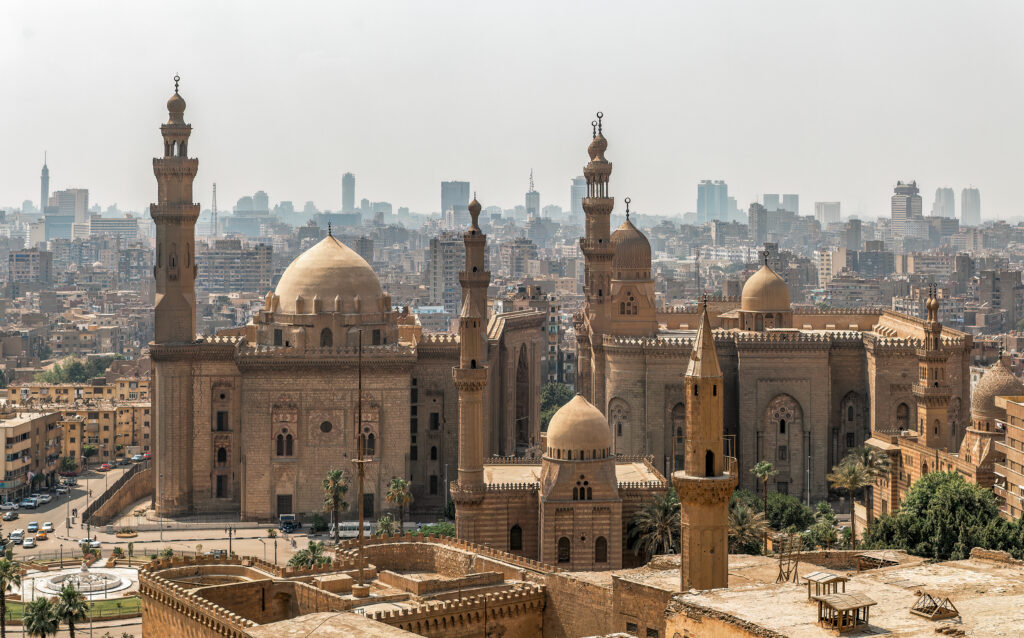
I wasn’t sure what I would think of Cairo. The city is not usually my preferred habitat. I would much rather spend my time exploring the outdoors. And Cairo isn’t just any city, but a megacity, with population of over 22 million people. “Hustle and bustle” doesn’t even come close!
So I was surprised by just how much I enjoyed the Egyptian capital. It certainly is full on and exhausting. But the sheer variety of history and culture in every neighbourhood makes for a really fascinating start or end to your Egyptian adventures.
GETTING THERE
Cairo’s International Airport (CAI) has direct flights to destinations around the world. From Cairo International Airport, you can get to Old Cairo in 30-40 minutes, the Giza Pyramids in 50-70 minutes, and New Cairo in 15-20 minutes. All of this is very dependent on the infamous Cairo traffic… The easiest way to get from the airport to anywhere in the city is Uber.
You can apply for a visa from the official Visa2Egypt portal or at your nearest Egyptian Consulate. Tourist visas granted using the e-visa system are valid for a maximum of 3 months. If you wish to get a visa on arrival, you can do so at approved bank kiosks within airport arrival halls, before reaching immigration counters. The visa fee is $25, payable in US dollars as the preferred currency, although you may also be able to pay in pounds sterling or euros. Visas granted on arrival are valid for a maximum of 30 days. Do not stick the visa into your passport yourself; the immigration official will do this at the desk when they stamp your passport.
There’s no need to buy a visa from an agent. In many cases agents will charge more than US$25 for a visa. If you’re harassed by an agent, report the incident to the tourist police in the airport terminal.
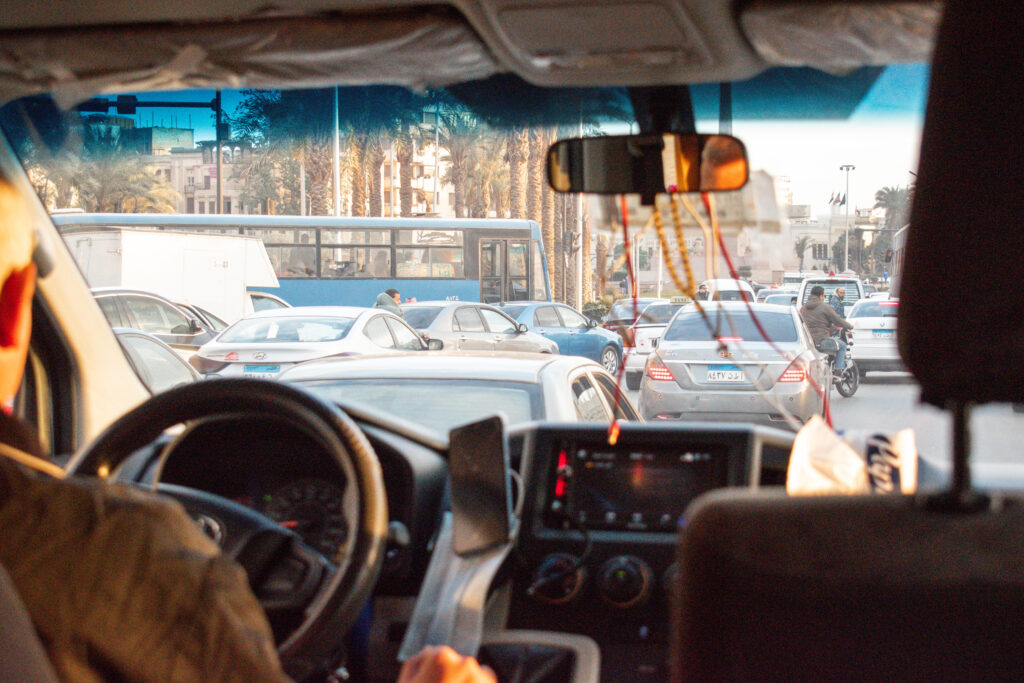
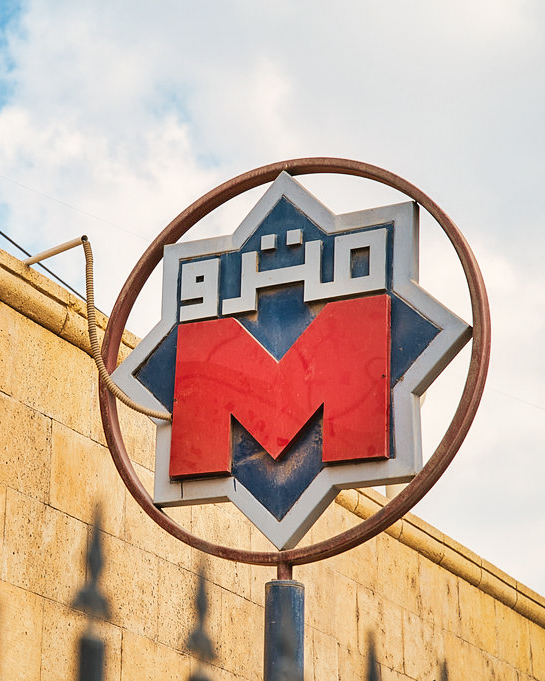
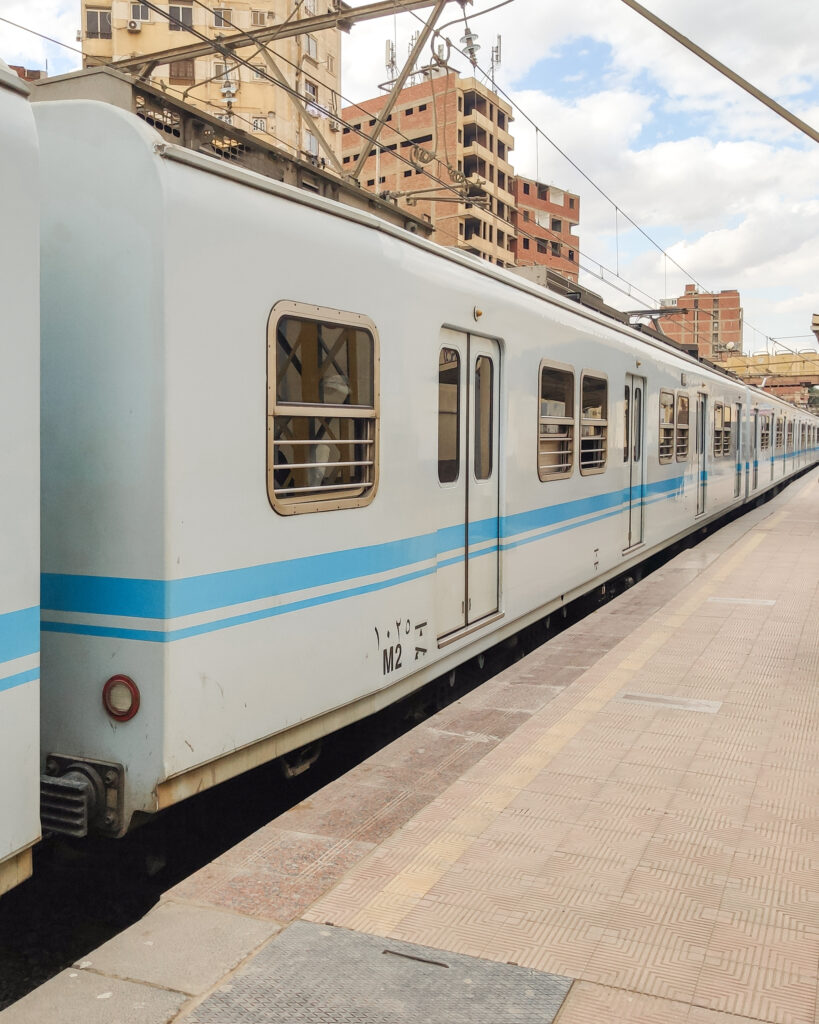
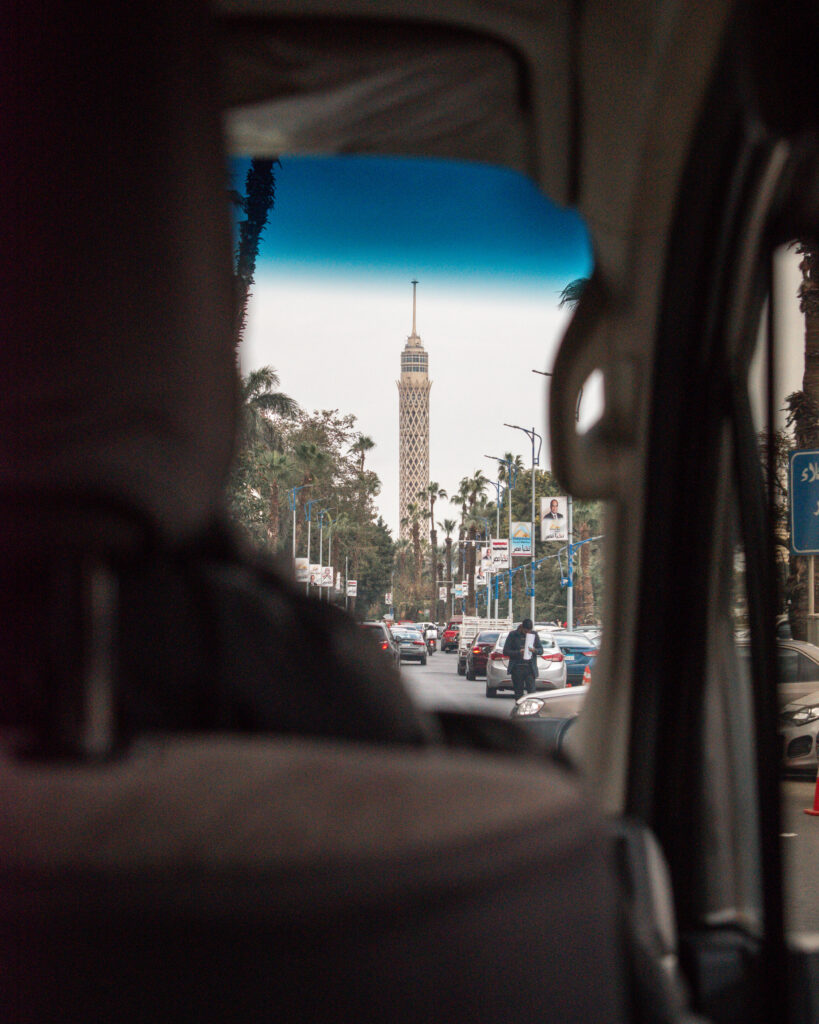
GETTING AROUND
No matter how confident you think you might be driving, do not try to drive in Cairo. I have lived, travelled and driven in some places with some fairly terrifying road systems. But nowhere, absolutely nowhere, has come close to Cairo. The traffic and utter chaos (or at least as it appears to an outsider) is unmatched!
Taxis are the easiest way to get around Cairo. Uber is widespread, easy to use and offers the best value.
Cairo also has a reasonable metro system, with rates fixed by zone, but it doesn’t cover the whole city. Prices depend on the number of stops. The metro is open from 5am to 1am every day of the week, and there are cars on every train reserved for women. There are plans to open a line that connects all the way to Giza, but that has yet to come to fruition.
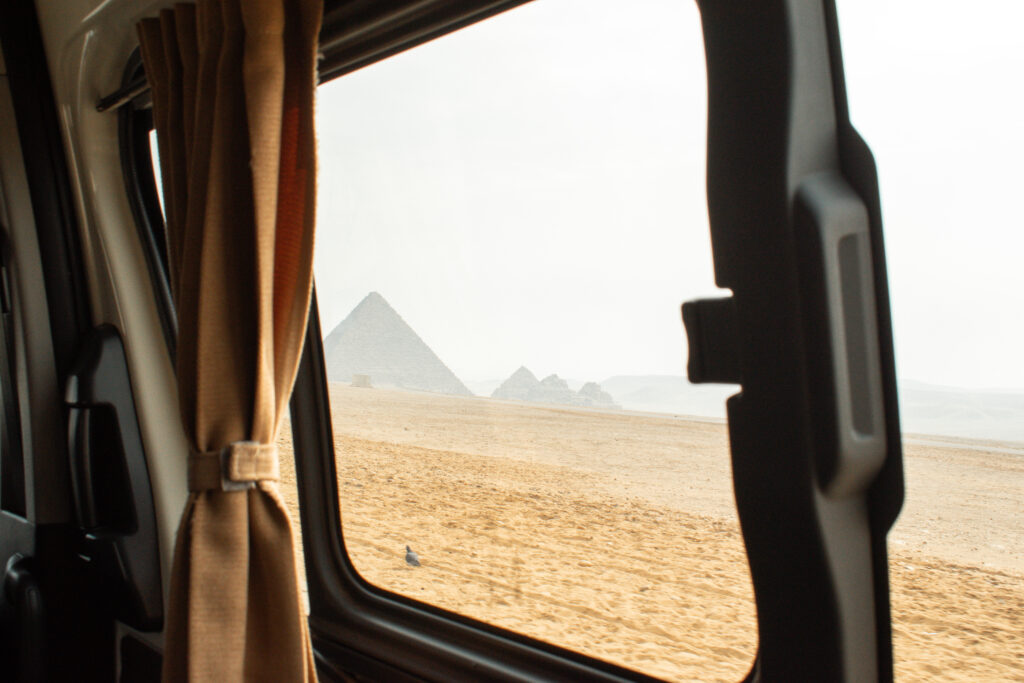
CAIRO GUIDES OR INDEPENDENT TRAVEL?
I tend to prefer independent exploration, over guided sightseeing. But in Cairo – and the entire of Egypt! – the span of Egyptian history is simply so vast, we felt we needed someone to help us put some of it into context for at least some of the time! I therefore recommend a mixture of days with a guide, and days exploring independently.
If you do decide to hire a guide, I can’t recommend our guide Amr Ahmed, highly enough. He was fantastic at helping us make the most of our time in Cairo, and was staggeringly knowledgeable about all things Egypt. He was always willing to flex all of our trips to suit what we wanted on the day, and was thoroughly enjoyable company! (+2 01222 478 510; uschsmyft@gmail.com).
More generally, we have almost always booked tours and guides through Get Your Guide, as I find they tend to have the best prices for small group, or private tours. I have suggested a number of specific tour options below, under each section.
TIPPING
Known as “backsheesh”, tipping is such standard practice in Egypt it is almost a part of the culture. Tipping 10% of your bill is standard at cafes and restaurants, whilst loose change is acceptable for street vendors. For smaller purchases, rounding up the bill or not asking for any change is appropriate. Note that the service charge on your bill goes to the establishment, not the waiter or waitress, so you are expected to leave some cash on top.
It is also important to tip drivers and guides, but the amount is more complicated as comes down to service and quality. As a general rule, most we spoke to advised tipping a driver £50LE and a tour guide about £100LE for a full day tour.
Finally, and perhaps most importantly, when you first arrive in Egypt be sure to change a larger note into a handful of £5LE notes… you will need these to pay the attendant (and acquire toilet paper!) to use the bathrooms almost everywhere you visit. The bathrooms at the Great Pyramid of Giza are, rather bizarrely, ticketed, and cost £10LE for non-Egyptians (£5LE for Egyptians).
A QUICK NOTE ON PACKING
Living in Oman, I am used to covering up from wrist to ankle, and wearing a headscarf to enter the few mosques that permit non-Muslims visitors. When I asked our Egyptian guide what I needed for our day in Islamic Cairo, he seemed perplexed that as a non-Muslim I would think I needed to cover my head or dress differently. However, others advised modest dress for the mosques. We saw a mixture of clothing amongst visitors, but I definitely felt more comfortable and less conspicuous wearing more modest clothing. None of the mosques we entered required me to wear a head covering. Most mosques in Cairo permit photography, but as ever, avoid photographing anyone praying.
Likewise, in Coptic Cairo be sure to dress appropriately to enter the churches – which are generally more conservative and orthodox than you will find in Europe or America – and be sensitive about what and when you photograph.
DOWNTOWN CAIRO
THE EGYPTIAN MUSEUM
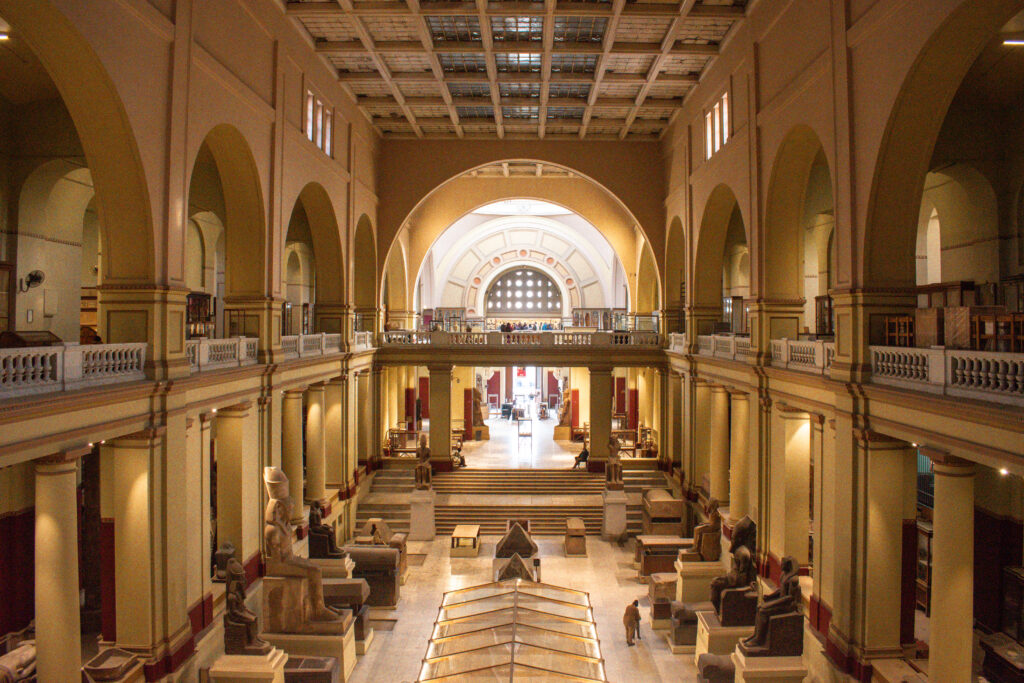
One of the most famous museums in the world, and an absolute treasure trove of ancient artifacts! More than 120,000 items are on display – including the most famous of all, Tutankhamun’s burial treasures.
The museum gets very busy, especially once the tour groups arrive. I therefore recommend arriving early to beat the crowds. This is also one of the destinations I would strongly encourage you to consider getting a guide. There is simply so much to see, and the spread of history on display so vast, that it can be rather overwhelming! Amr (details above) took us around the museum, meaning we saw items we would never otherwise have discovered, and was able to link it all up together in context for us. There are lots of well recommended private and small group tours on offer, via Get Your Guide.
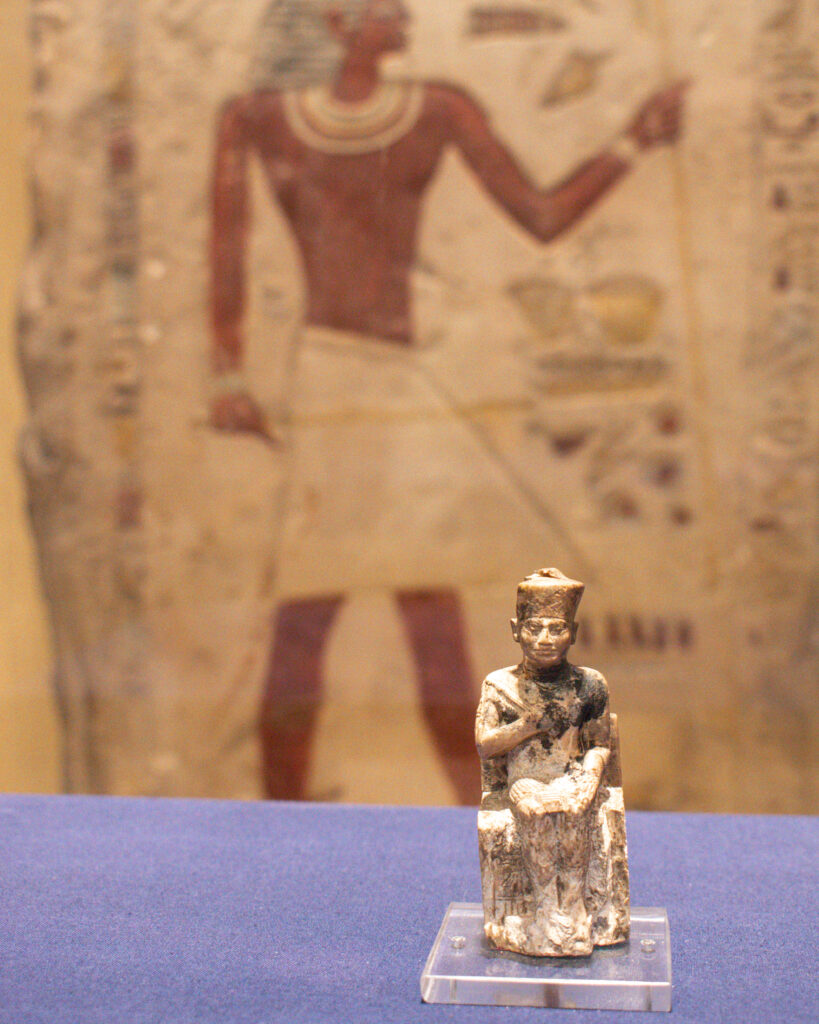
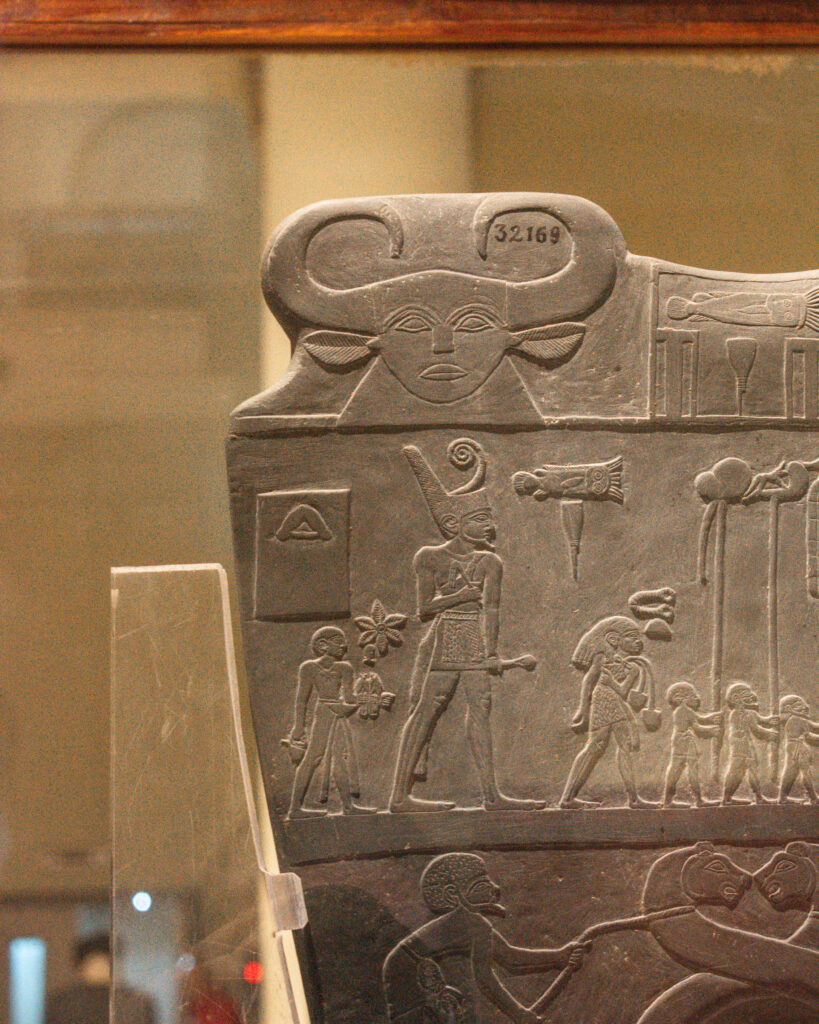
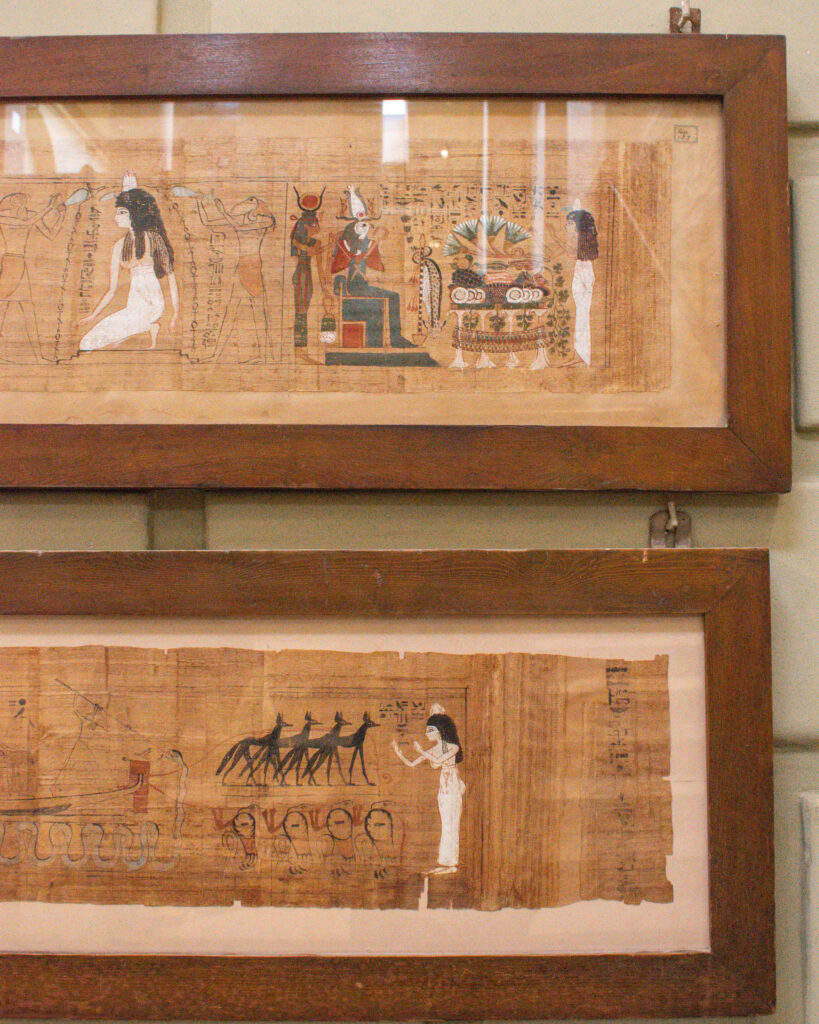
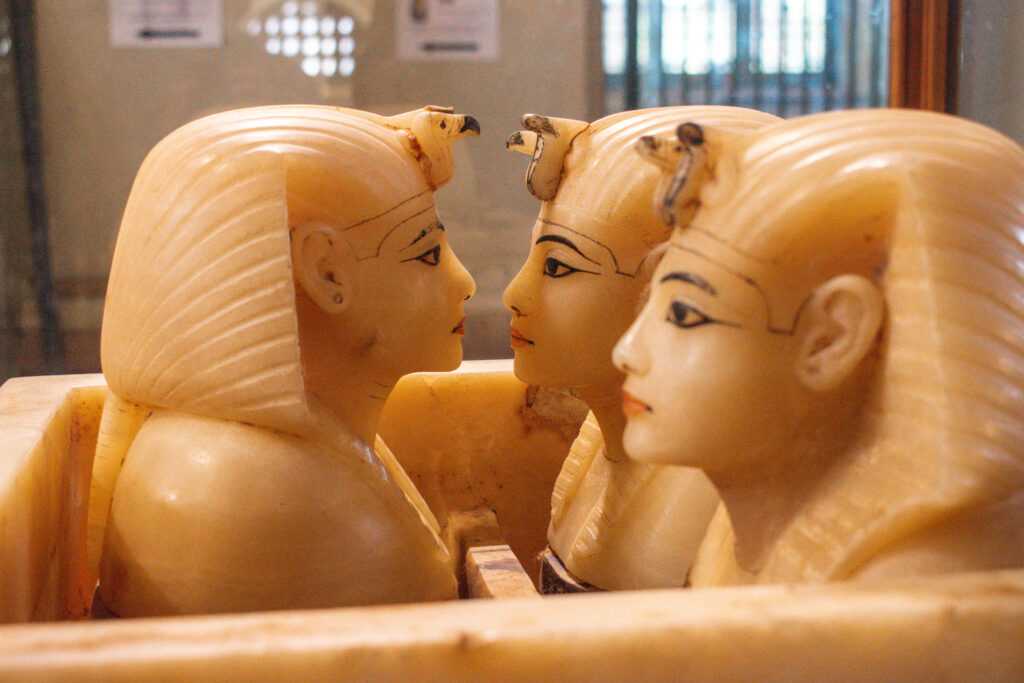
Alternatively, you could do a bit of research beforehand and pick out the exhibits you most want to see. My personal highlights were:
- Fan of Tutankhamen – I kept promising myself I wasn’t going to be awed by the treasures of Tutankhamun simply because it sparkled… but wow, seeing Tutankhamun’s death mask and coffins was genuinely mind blowing. To see something so truly iconic is a privilege, and they were even more exquisite in person than I could have imagined. The extent of beautiful, intricate items is amazing and it was hard to believe they are over 3,000 years old. It is hard to pick a favourite, but the ostrich fan is definitely a contender. Made of wood covered with sheets of gold and inlaid with coloured glass, turquoise, lapis lazuli, carnelian, and translucent calcite, this ceremonial fan originally held ostrich feathers.
- The Narmer Palette – ceremonial siltstone carving depicting the First Dynasty king Narmer conquering his enemies and uniting Upper and Lower Egypt. It features some of the earliest hieroglyphics found in Egypt and dates to c. 3000 BCE.
- Papyrus texts – there are numerous papyrus texts, mostly of the Book of the Dead, throughout the museum. The intricate detail and exquisite workmanship is simply astounding given how old they are. Most depict the Book of the Dead, a funerary text used from the beginning of the New Kingdom (around 1550 BCE). It consisted of a collection of spells intended to assist a dead person’s journey through the Duat, or underworld, and into the afterlife. You can read more about death in ancient Egypt in my reference guide to the Valleys of the Kings and Queens.
- King Khufu’s Statue – this teeny statue is the only known image of King Khufu, builder of the Great Pyramid of Giza. Something about it’s miniature size, set against the colossal sculptures in the rest of the museum, was hugely endearing.
GRAND EGYPTIAN MUSEUM
The new Grand Egyptian Museum, in Giza, is due to open in 2024. This huge complex looks extremely impressive from the outside and promises to offer a more immersive history of ancient Egypt. It will be the largest archaeological museum in the world, housing a vast collection of artefacts, including the complete Tutankhamun collection. Many of these artefacts will be on display for the first time. The museum is offering limited guided tours of the areas currently completed, with the official opening expected in Spring 2024.
NATIONAL MUSEUM OF EGYPTIAN CIVILIZATION
The National Museum of Egyptian Civilisation is a large museum devoted to Egyptian civilisation. Unlike the GEM and the Museum of Egyptian Antiquities, it covers the entirety of Egyptian history. It houses a collection of 50,000 artefacts, presenting from prehistoric Egypt, the Greco-Roman, Coptic, and Islamic eras to the present day.
Highlights include The Mummies Hall, which displays the mummies of the ancient Kings and Queens of Egypt. The most famous mummies are Hatshepsut, Thutmose III and Segenenre Tao II. In April 2021, these Pharaohs were moved from the museum in Tahrir Square to their new resting place in the National Museum of Egyptian Civilisation in a spectacular televised parade. I can’t imagine how stressful a day this must have been for the poor museum directors!
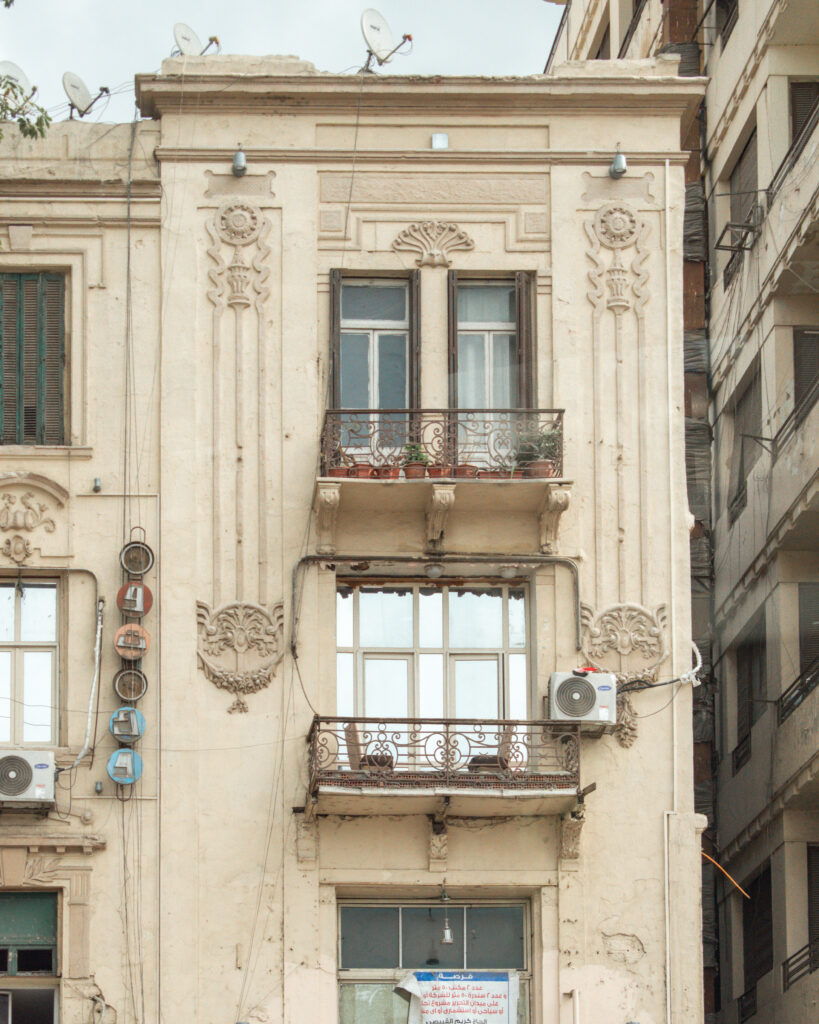
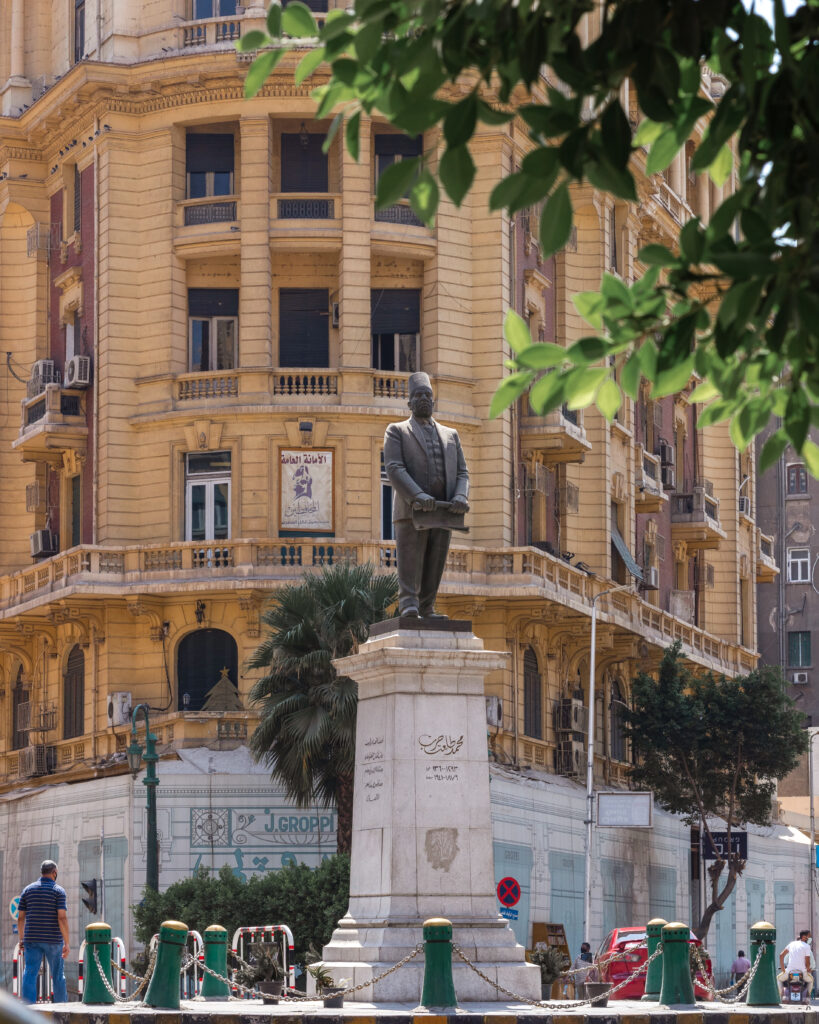
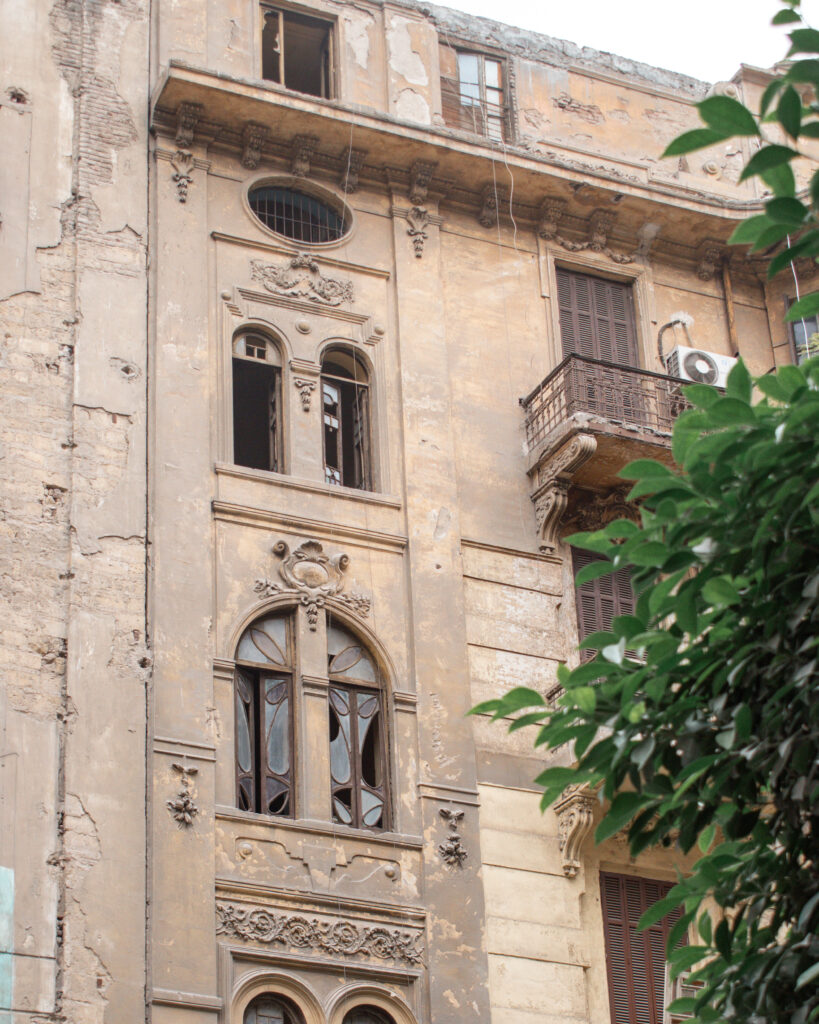
TAHRIR SQUARE
When thinking of Cairo’s history, the Pyramids of Giza may be the first images that come to mind. But this busy intersection, is almost more important than any of the ancient sights for Egypt today. Tahrir Square has been epicentre of many of the protests and uprisings that have shaped Egypt. It became the focal point of the 2011 Egyptian revolution, when thousands of Egyptians took to the streets to stand against President Hosni Mubarak and his government. It was also the site of the 1919 Egyptian Revolution, after which it was gained its current name, meaning Liberation Square, although it wasn’t officially changed till 1952.
ISLAMIC CAIRO
The known as Islamic Cairo is a UNESCO World Heritage Site that dates back to the 14thC. I’d recommend getting a guided tour around Islamic Cairo and its various sights (have a look at this private tour which includes the Citadel, mosques and Souq), before spending a few hours sipping mint tea and souvenir shopping in the Souq.
KHAN EL KHALILI
Cairo’s famous medieval souq, Khan El Khalili, is a rabbit’s warren of densely packed alleyways, mosques, Ottoman-era mansions and endless souvenir shopping.
MUIZZ STREET AND AL HAKIM MOSQUE
One of the oldest streets in Cairo, filled with wonderful examples of Islamic architecture including the unusual Al Hakim Mosque with its red brick minarets. Check out this excellent map if you want to explore independently.
SALADIN/CAIRO CITADEL
The Saladin Citadel – also known as Cairo Citadel – sits on top of a hill overlooking old Cairo. The citadel was built for protection against the Crusaders between 1176 and 1183, and was the seat of the Egyptian government until the 19thC. The present-day Citadel complex encompasses mosques, museums and the Al Gawhara Palace. It offers super views of the city below – and on a clear day, out to the Pyramids at Giza.
The Citadel is open daily from 8am to 5pm. Adult tickets are £200 LE, and can be bought at the entrance. It is possible to combine a private tour of the Citadel with a visit to Cairo’s famous market – Khan El Khalili.
Mosque of Mohammed Ali
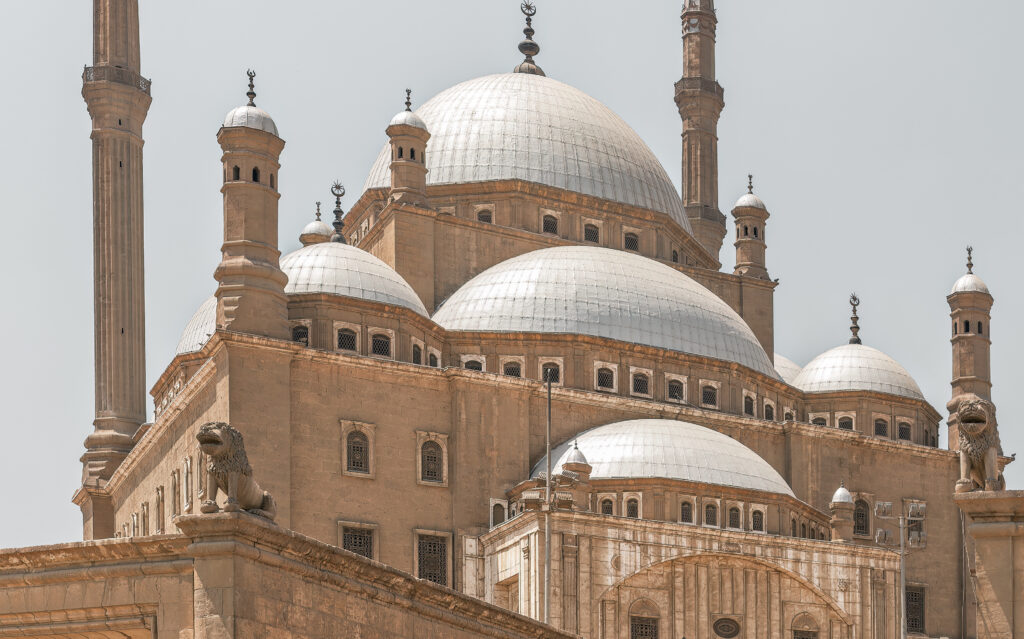
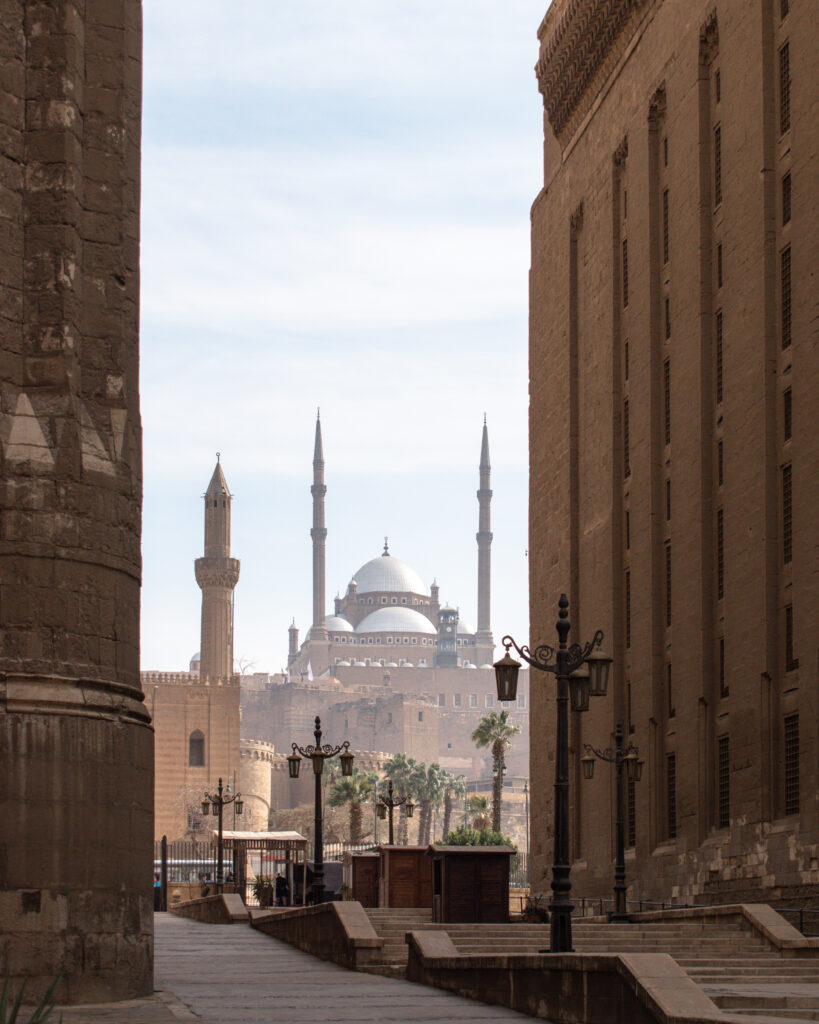
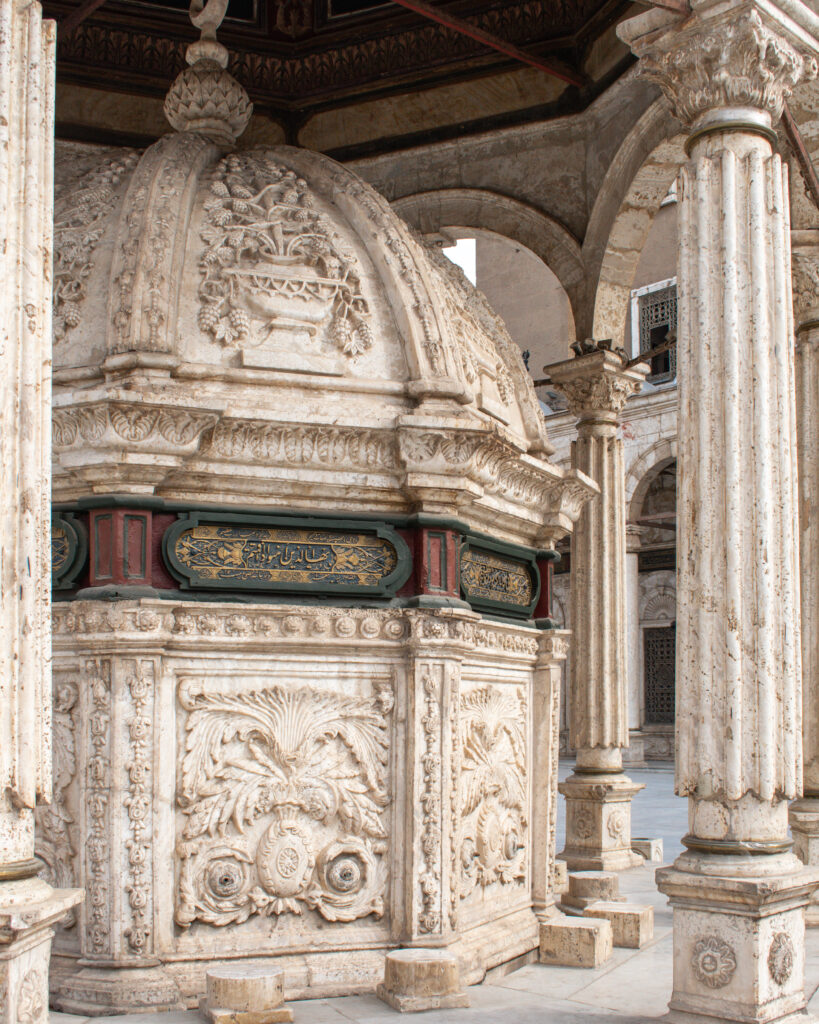
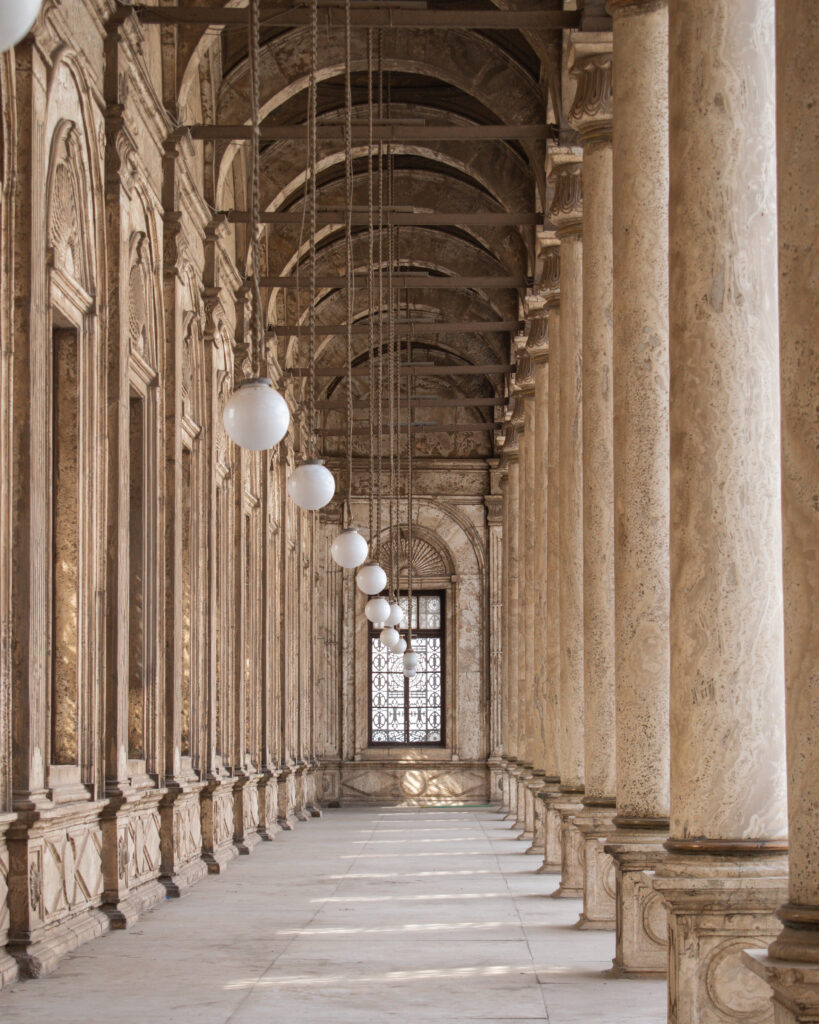
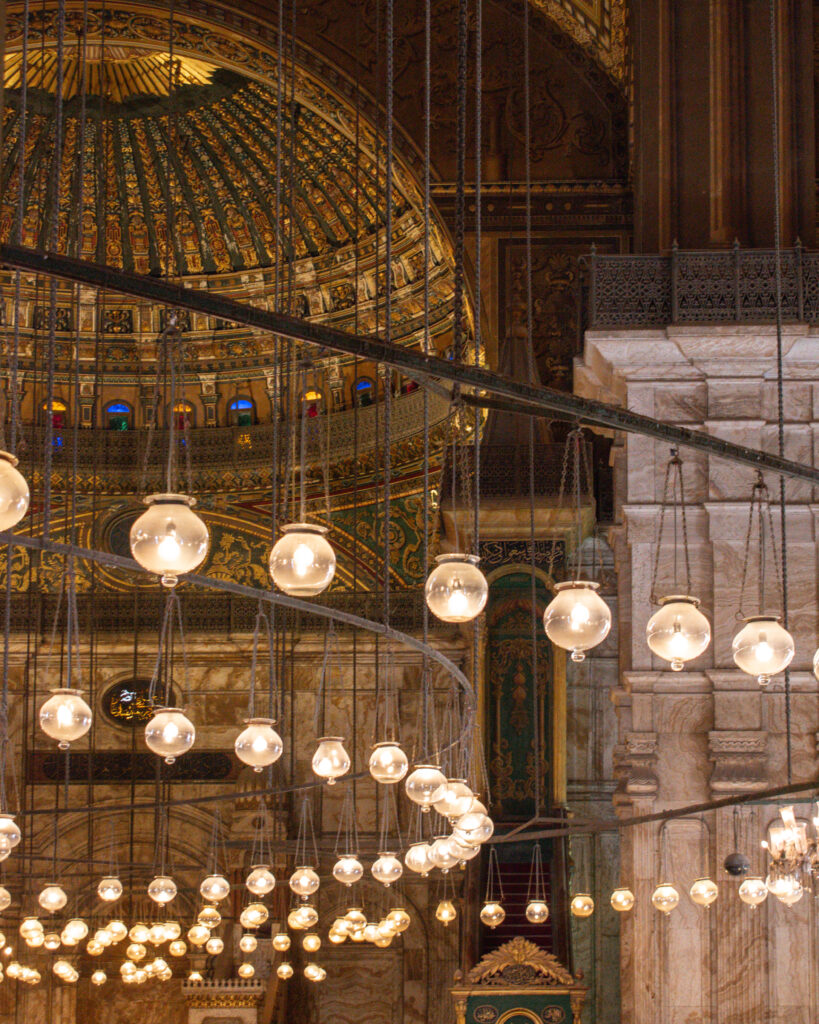
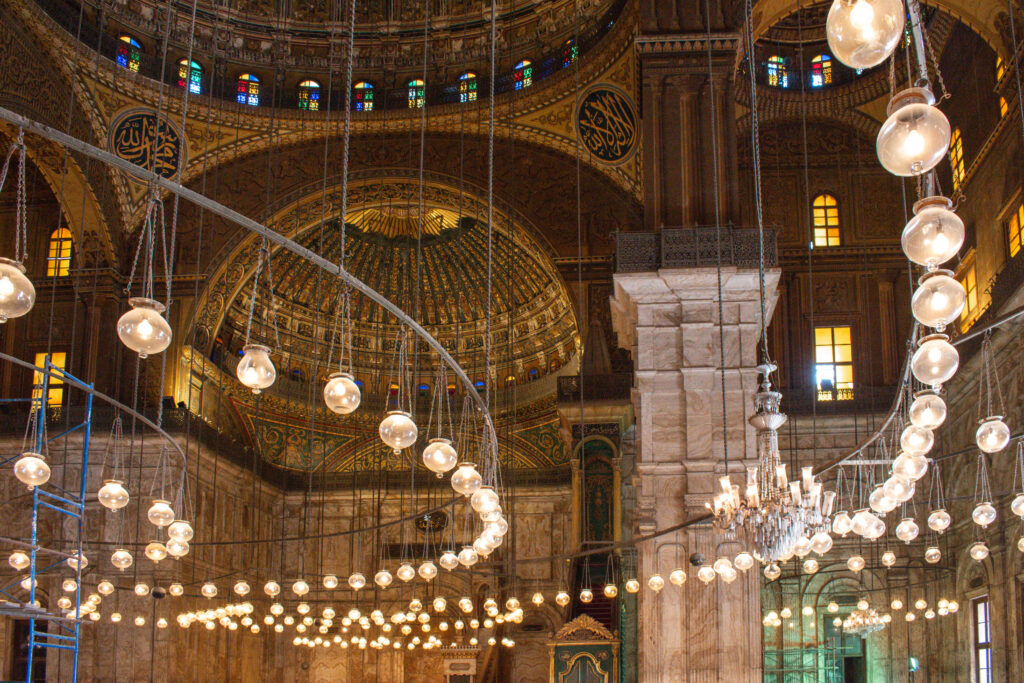
The Mosque of Mohammed Ali is probably the most visited sight within The Citadel. Commissioned by Muhammad Ali Pasha between 1830 and 1848, it was a declaration to his Ottoman overlords of Egypt’s newfound independence.Mohammad Ali – known as the “father of modern Egypt,” – was a reformer who wanted to distance himself from the influence of six centuries of Mamluk rule. At the height of his rule, he ruled over Egypt, Sudan, Hejaz, Najd, the Levant, Crete and parts of Greece.
The interior of the mosque is beautiful. The high domed ceiling is hung with low hanging lanterns which reflect on the polished floor. There are 6 medallions around the dome that include the names of God, the Prophet Mohamed and the four caliphs, or the “rightly guided” rulers who reigned right after Mohamed (Abou Bakr, Omar, Othman, and Ali). The main prayer space can hold up to 6,500 worshippers. The mosque is also known as the Alabaster Mosque given the marble coated first floor.
There is an elaborate French clock in the courtyard. Gifted to Mohammad Ali in 1845 by French King Luis Philip in exchange for the obelisk that now stands at the Place de la Concorde in Paris. It was a pretty poor gift though – the French clock has never worked!
Mosque of Mamluk Sultan Al-Nasir Muhammad
On the opposite side of the street to the Mosque of Mohammed Ali stands the Mosque of Mamluk Sultan Al-Nasir Muhammad. Unlike many mosques in Cairo, the decoration is fairly plain. But it more than makes up for this in the amount of history packed into these walls. This was once Cairo’s royal mosque, and the destination of choice for the Sultan’s Friday prayers. Today it’s the only remnant of Mamluk rule at the citadel that wasn’t removed by Muhammad Ali.
The mosque was constructed in 1318 during the longest of the three reigns of Al-Nasir Muhammad. Up until the 16thC, the mosque was considered to be one of Cairo’s most beautiful. But after the collapse of the dome over the prayer niche, the Ottoman conqueror Sultan Selim I removed the mosque’s marble panels to Constantinople.
The Fortress
The best views of Saladin’s vast medieval fortress – the actual citadel – are from outside the complex. You will see some of the Citadel’s four gates and thirteen towers on your way to and from the complex. The walls were built in part from blocks taken from Giza’s smaller pyramids.
The huge Bab al-Azab gate can be seen from the square in from of Sultan Hassan Mosque. It was here that Muhammad Ali invited Cairo’s remaining Mamluk rulers to a banquet at the Citadel. As they were leaving through Bab al-Azab, he had them all shot. Known as the Massacre at the Citadel, the nearby Darb al-Ahmar (The Red Road) gets its name from the Mamluk blood that was said to have flowed down the streets.
Cairo Citadel Museums
There are several small (and pretty niche!) museums within the Citadel complex, but it can be fairly hit and miss as to whether they are open:
- The Royal Vehicle Museum – vehicles used by Mohammed Ali’s family;
- The Military Museum – Egypt’s military history from Ancient Egypt to modern times. This building was once Muhammad Ali’s private residence;
- The Police Museum – exhibits on famous political assassinations;
- The Archaeological Garden Museum – collection of decorations from the medieval and Ottoman eras;
- The Gawhara Palace – Muhammad Ali’s personal residence, including his gilded wood throne.
Al Azhar Park
Not too far from the Cairo Citadel is Al Azhar Park. This lovely green space offers wonderful views over the Citadel and the minarets of the city’s skyline. The Citadel Restaurant has lovely terraces with lovely views. Unfortunately the food is distinctly average, so instead I suggest coming for a sunset drink after you have toured the Citadel. No alcohol.
MOSQUE OF IBN TULUN
Mosque of Ibn Tulun. It is one of the oldest complete mosques in Africa, built between AD 876 and 879. Its simplicity of design is beautiful. The Mosque of Ibn Tulun is also one of the world’s largest (measuring 26,318 square meters), having being designed to accommodate Ibn Tulun’s entire army during Friday prayers.
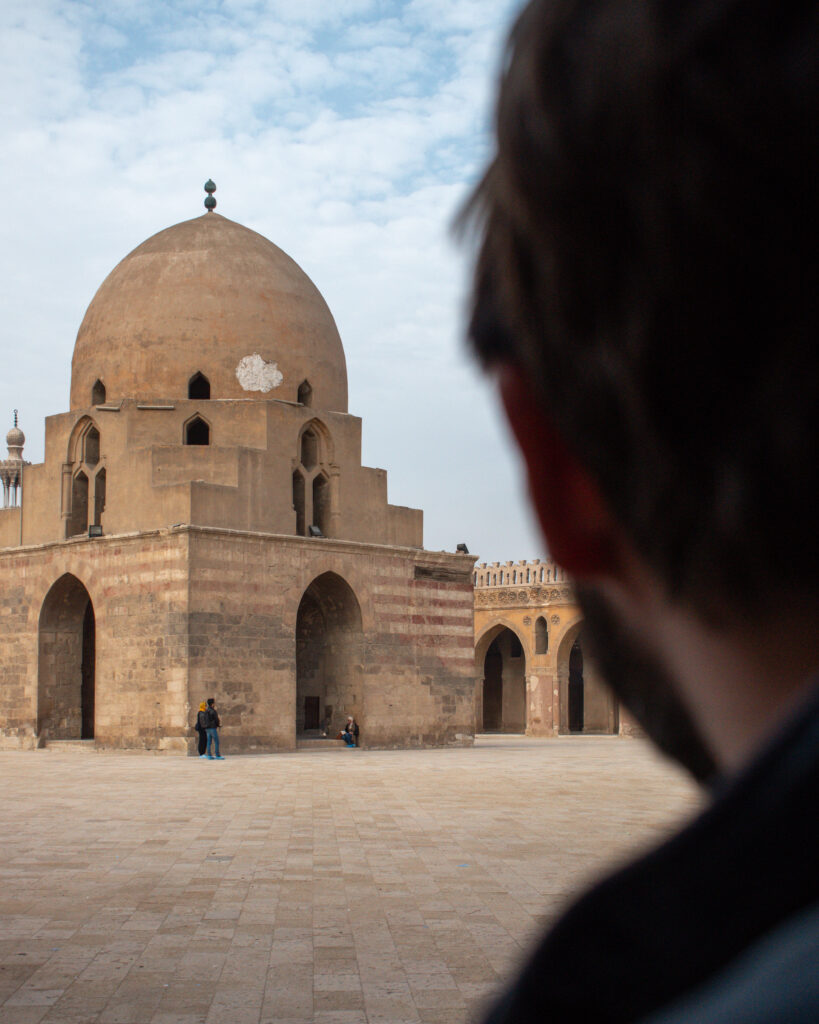
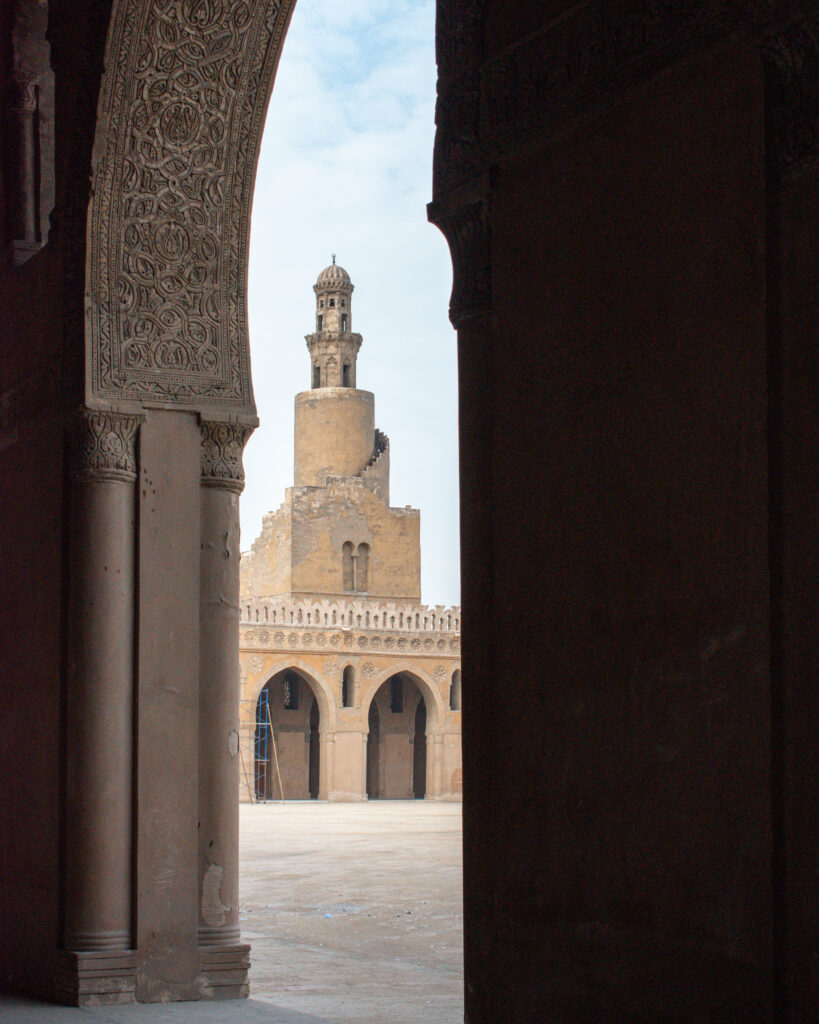
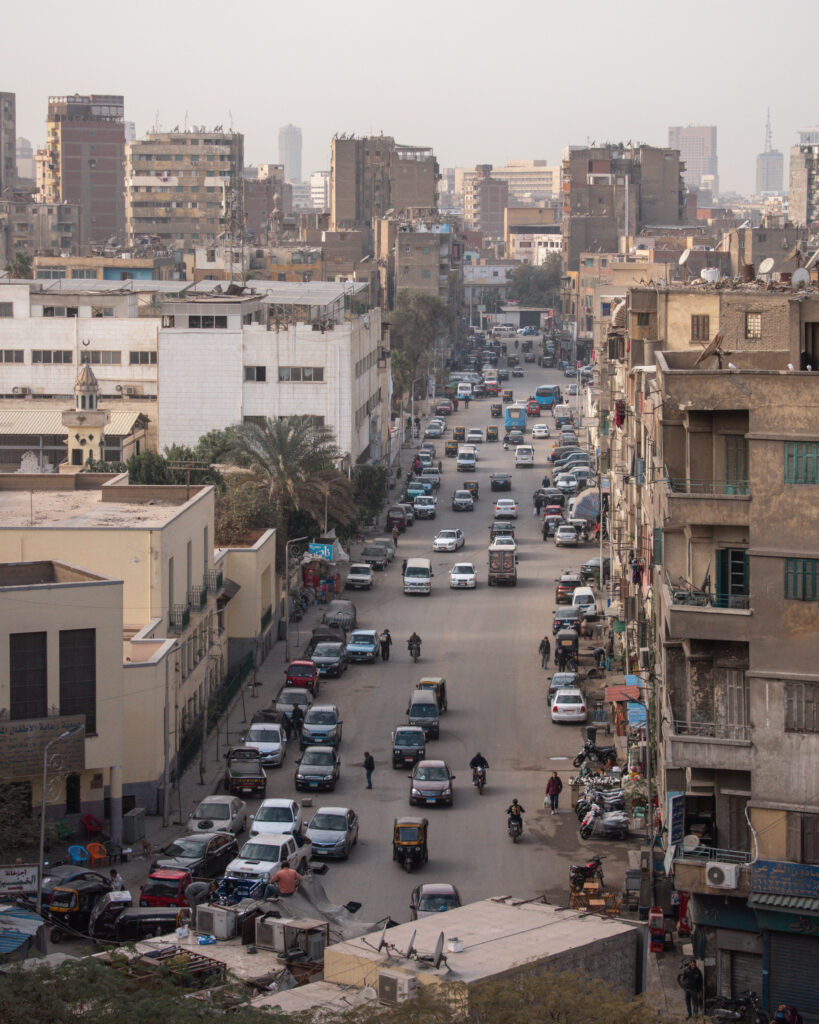
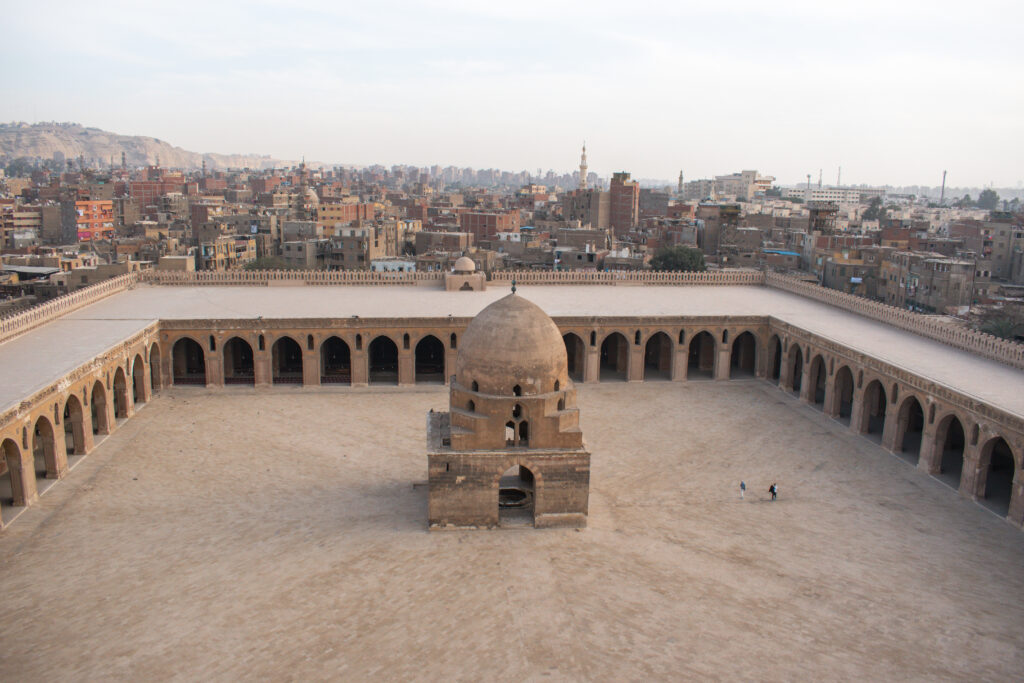
Ibn Tulun has an unusual spiral minaret with a – slightly vertigo inducing! – wrap around staircase. The legend goes that Ibn Tulun designed his minaret by chance. He was sitting with his officials and absentmindedly twisting a piece of parchment around his finger. When someone asked what he was doing, Ibn Tulun replied he was designing his minaret.
Ahmad Ibn Tulun was the founder of the Tulunid dynasty that ruled Egypt and Syria between 868 and 905. He was born into slavery, before rising through the ranks of the Army and eventually seizing control.
The mosque is open daily from 9am to 4pm, except Fridays when it opens after prayers at 1pm. Entrance is free.
MOSQUE MADRASSA OF SULTAN HASSAN
The Mosque-Madrassa of Sultan Hassan. Built in the 14thC, it covers a vast area of 7,906 sq m. It was built between 1356 and 1363 by Sultan Hassan, who took the throne at the age of 13, was deposed and reinstated three times, then assassinated shortly before the mosque was completed.
Once through the dark entrance way, a square courtyard is flanked by four vaulted halls or iwans. These four iwans were schools for all four of the Sunni doctrines: Shafli, Hanbali, Hanafi, and Maliki, and housed more than 400 students.
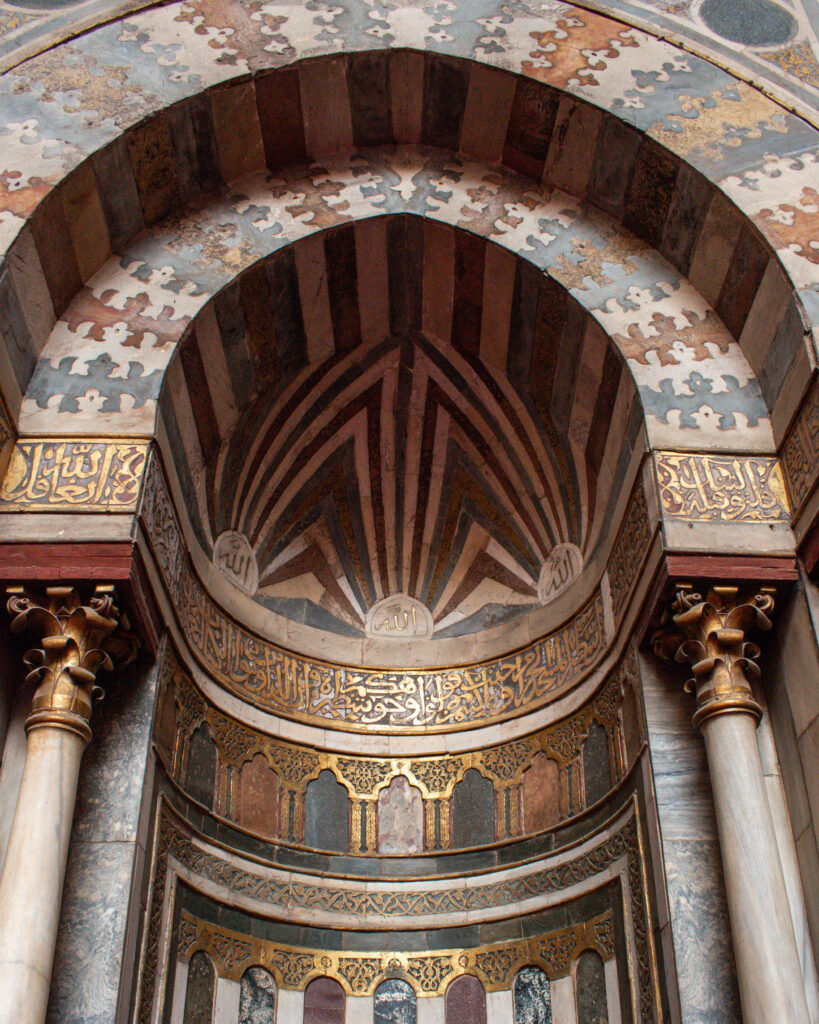
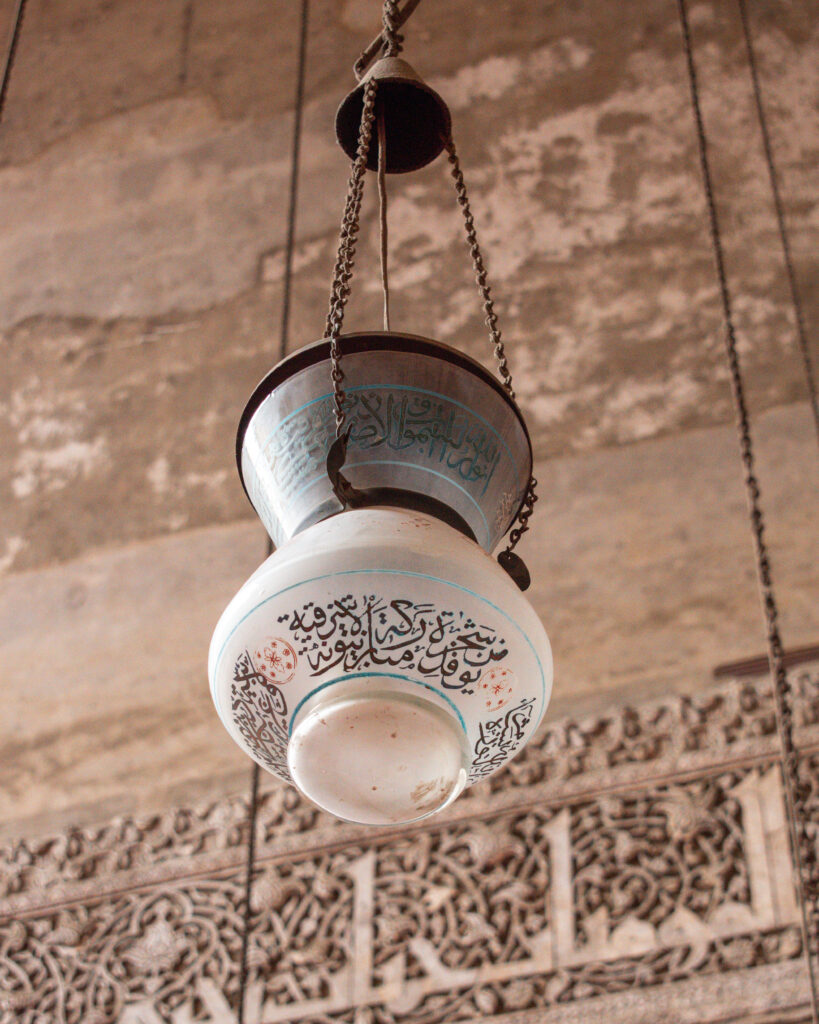
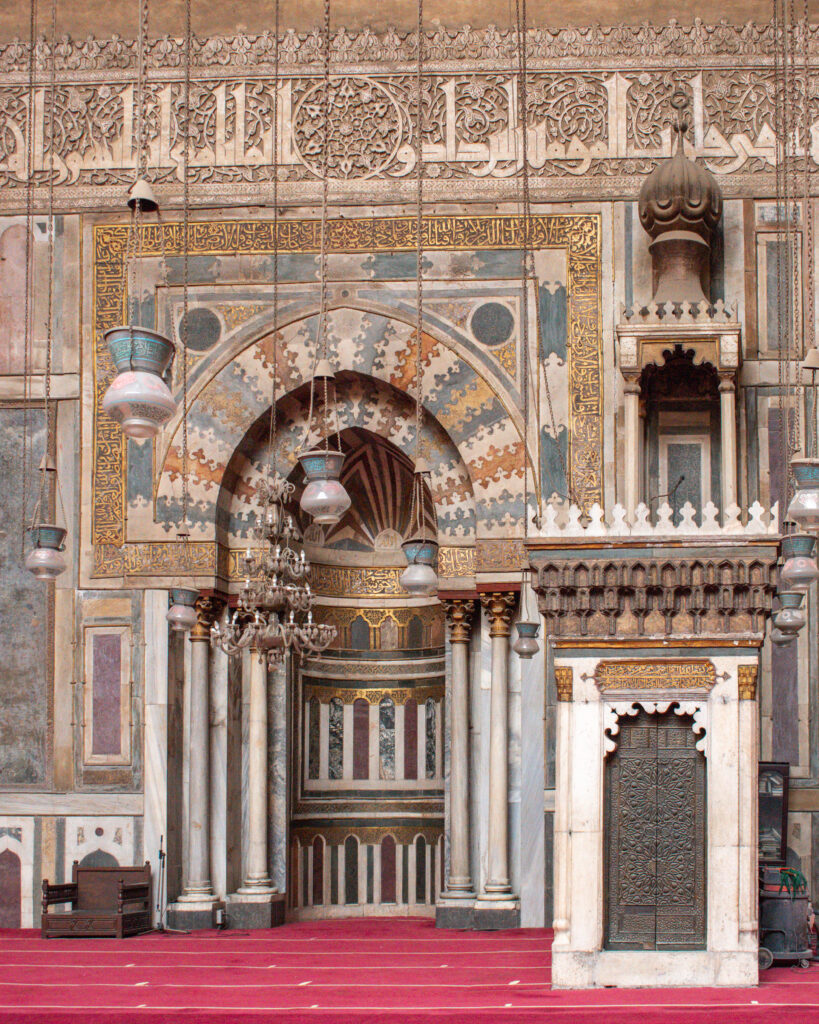
In 1517, the last Mamluk Sultan, Tumanbay, took refuge inside the mosque as the victorious Ottoman army marched into Cairo. The Ottomans bombarded the mosque with cannonballs, but public pressure later forced them to repair the damages.
Open daily, 8 am to 4.30 pm. Adult tickets (£80 LE) also include entry to the neighbouring Al Rifa’I Mosque (below).
AL RIFA’I MOSQUE
This turned out to be one of my Cairo highlights, as I knew nothing about the Al Rifa’I Mosque beforehand and yet it is jam-packed with history.
The enormous mosque was built over a period of 43 years, finally completed in 1912. It was constructed as part of the 19thC Egyptian rulers’ plan to modernise the capital city and embrace the glory years of Egypt’s Islamic history. The mosque’s design – especially its dome and minaret – is influenced by Mamluk architecture.
The mosque is also known as the Royal Mosque, as it is the final resting place of a number of modern Egyptian royals. The last Shah of Iran was also buried here, until his body was returned to Iran in 1950.
COPTIC CAIRO
The area known as Coptic Cairo – also Old Cairo – predates the founding of modern Cairo by several centuries. Settlements here date back to the 6thC BCE, when the city started to expand around the fortress guarding the canal linking the Nile and the Red Sea. Subsequently, the Romans built their own fortress, Babylon, which developed into a Christian stronghold. More than 20 churches were crammed into an area of only about one square mile. Today, only 5 remain but the neighbourhood continues be home for many of Cairo’s Christian population.
This is definitely an area of Cairo you can explore independently if you want to. It is a small area, and all the sights are within very close proximity of each other. Take a guide book (or copy of this excellent blog…!) as there are minimal information boards or signs available. Get the metro to Mar Girgis, or take an Uber.
THE FORTRESS OF BABYLON
The two 10m-high, stone towers greeting you to this area of Cairo are the remnants of a Roman fortress constructed in 98AD. They were part of a series of riverfront fortifications, and the waters of the Nile original came right up to their base. The towers are some of the oldest structures still standing in Cairo.
The Roman Emperor Trajan stationed his troops here to control Egypt, at a time when Cairo marked the boundary between Middle and Lower Egypt, and controlled all trade along the Nile from a canal connecting it to the Red Sea. When the Muslim Arab forces invaded Egypt in 639AD, the fortress defended the city for seven months before falling to the army led by General Amr Ibn Al As.
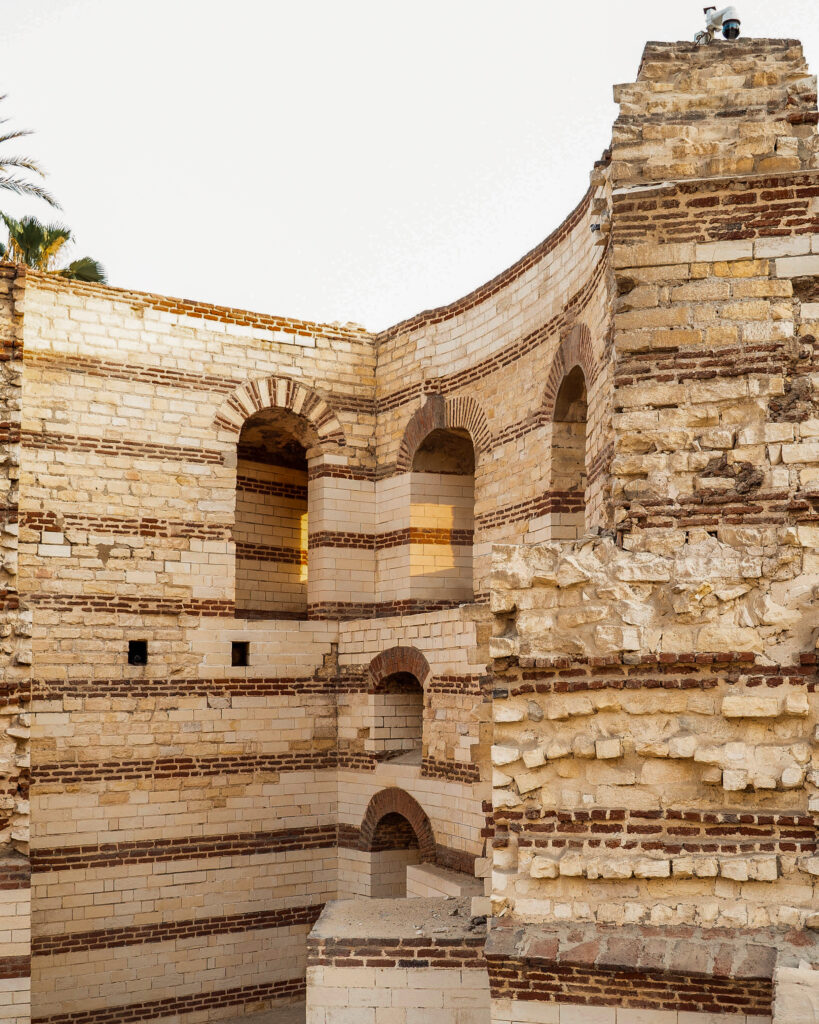
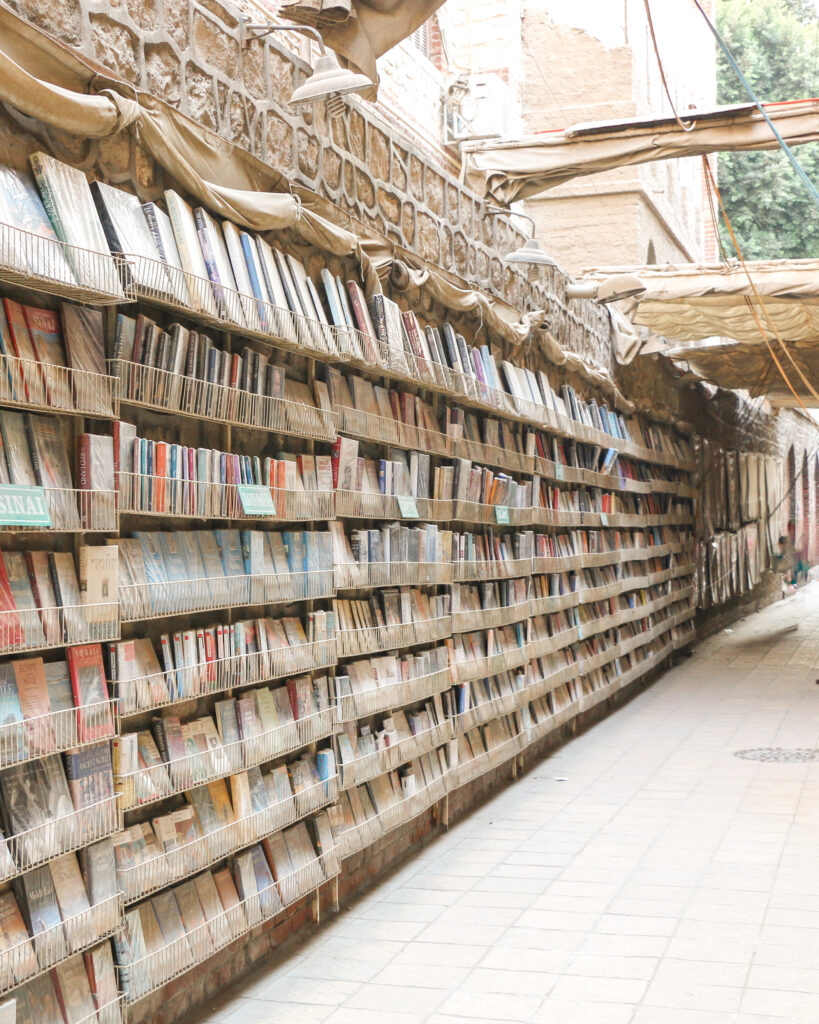
HARIT AL KIDEES GIRGIS (THE ALLEY OF ST GEORGE)
A lovely sunken alleyway that connects the Churches in the Coptic area of Cairo together, and is lined with book sellers, art dealers and side streets with residential dwellings.
THE HANGING CHURCH
One of the oldest churches in Egypt, and it’s the most famous Coptic Christian church in Cairo. Built on top of the southern gate of the old Roman fortress, palm tree logs and layers of stone were constructed above the ruins and used as the foundation of the church, “suspending” it between the two towers. Built as early as the 4th century AD (or 3rd, 7th or 9th, apparently everyone has a different opinion), The original structure – thought to date from as early as 4thC AD, was rebuilt in the 11thC and has been added to continuously since then. The famous facade, with its two towers, is a relatively modern addition, from the 19thC.
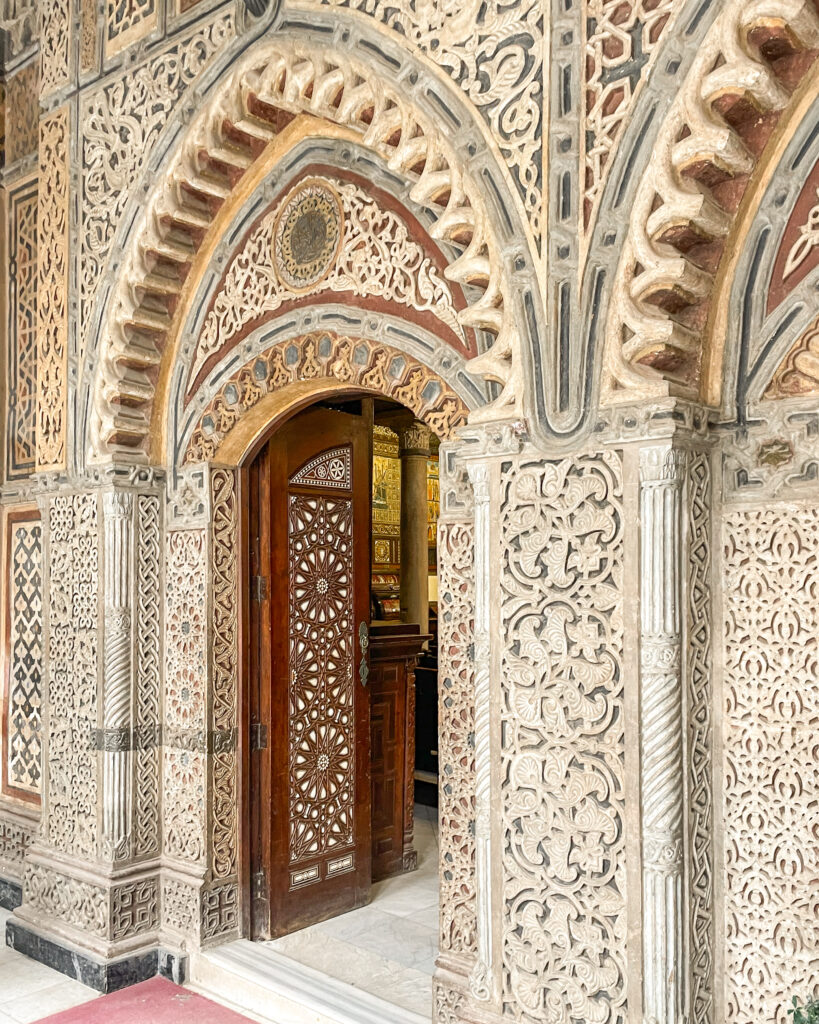
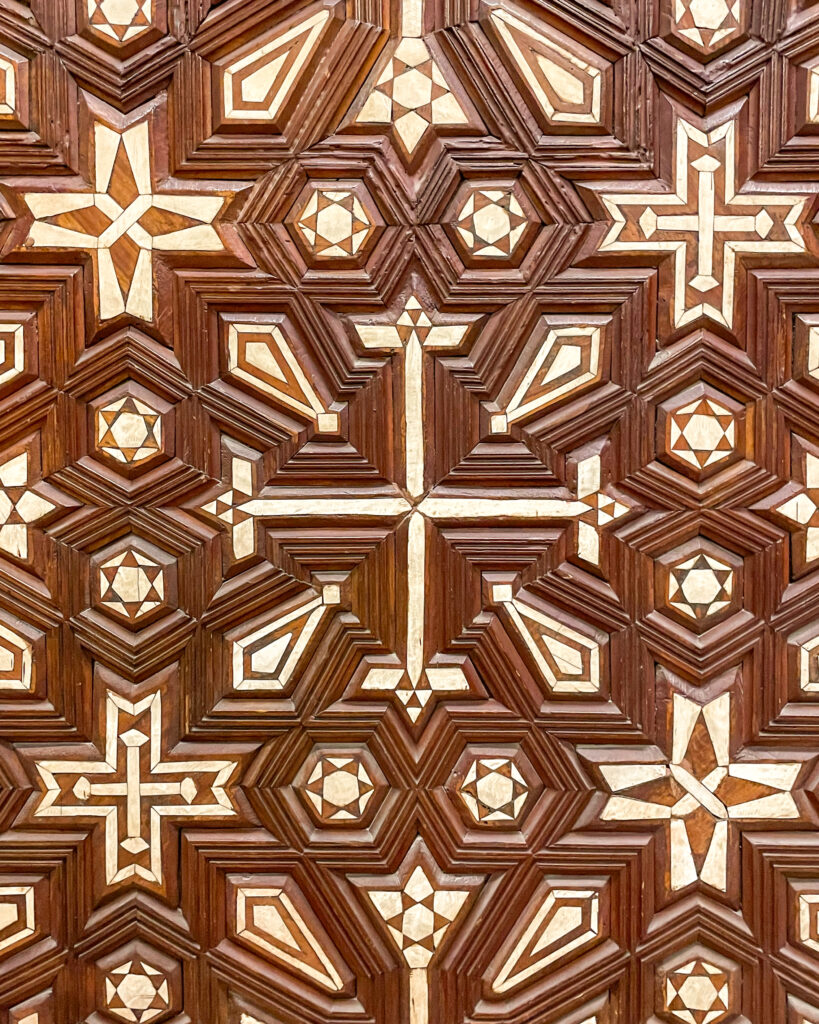
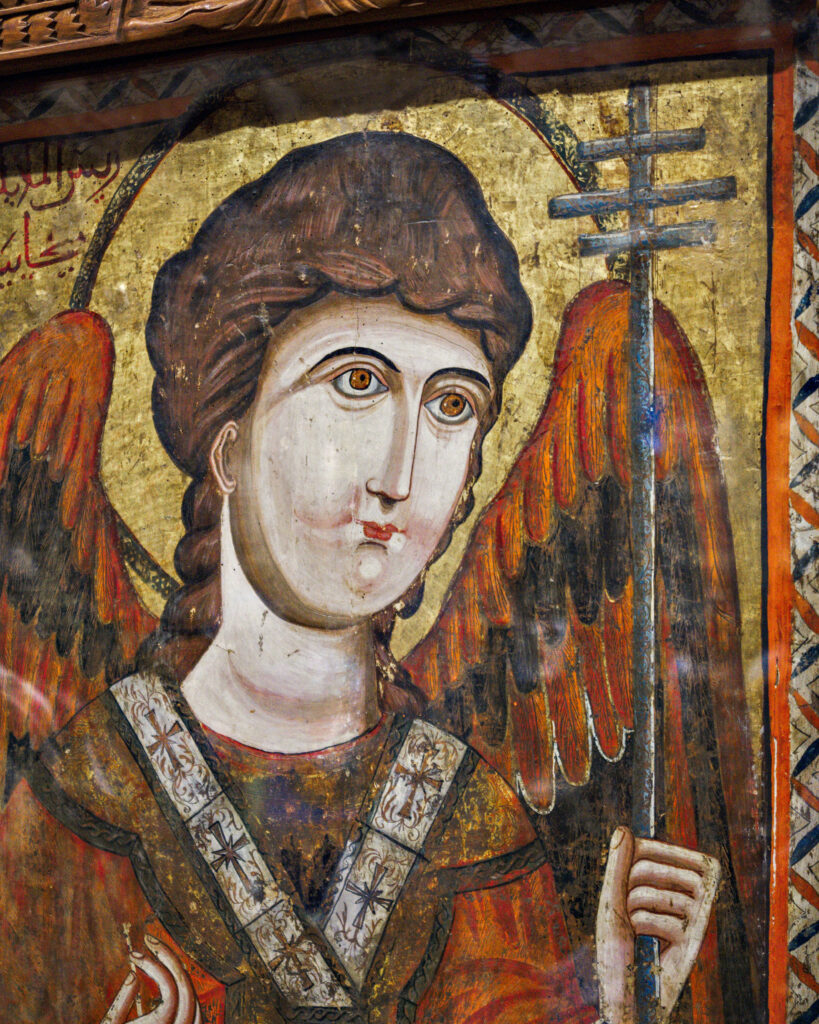
Photography is not permitted inside the Church, where you will find a vaulted wooden ceiling supporting by Corinthian columns taken from the earlier Churches. The 13 columns represent Christ, and his disciples. The darker column is believed to represent Judas. If you like religious iconography (after living in Russia, I am fully converted to this art form!) the Hanging Church is a must visit in Cairo. There are 110 icons adorning the walls, with the oldest and most well known an 8thC Virgin Mary known as The Coptic “Mona Lisa”.
THE CHURCH OF MARTYRS SERGIUS AND BACCHUS IN THE CAVE
More snappily known as Abu Sarga, this small Church is traditionally believed to have been built over a cave where the Holy Family rested at the end of their journey into Egypt.
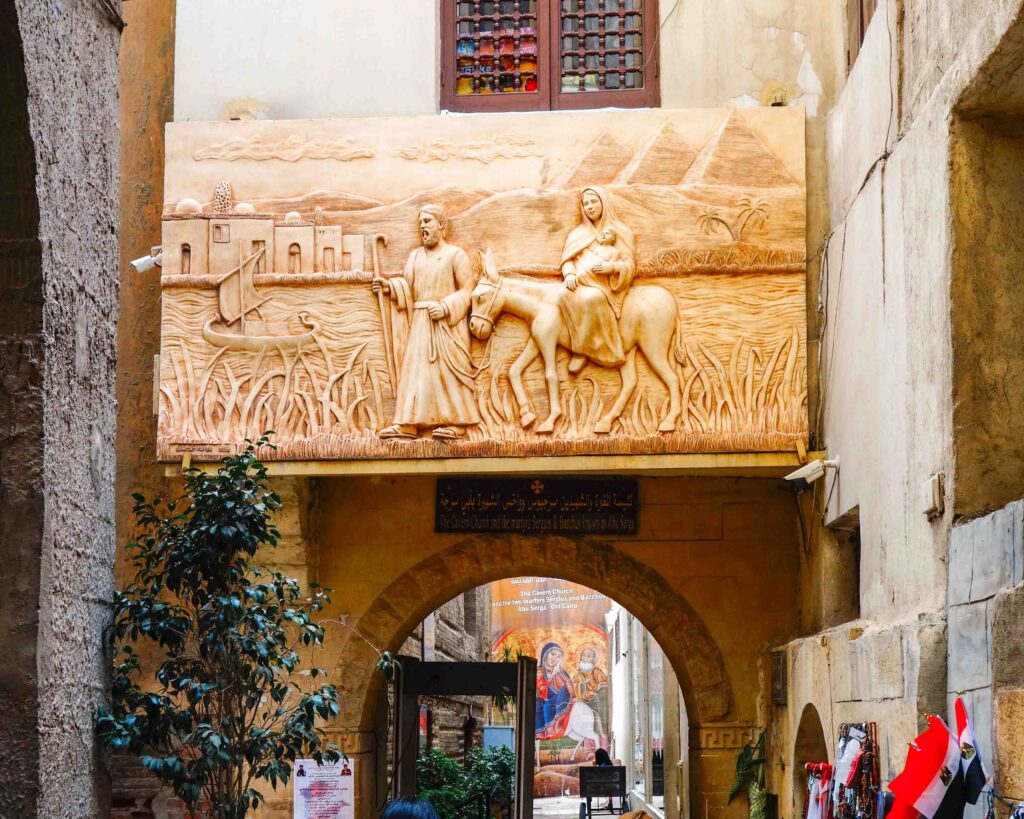
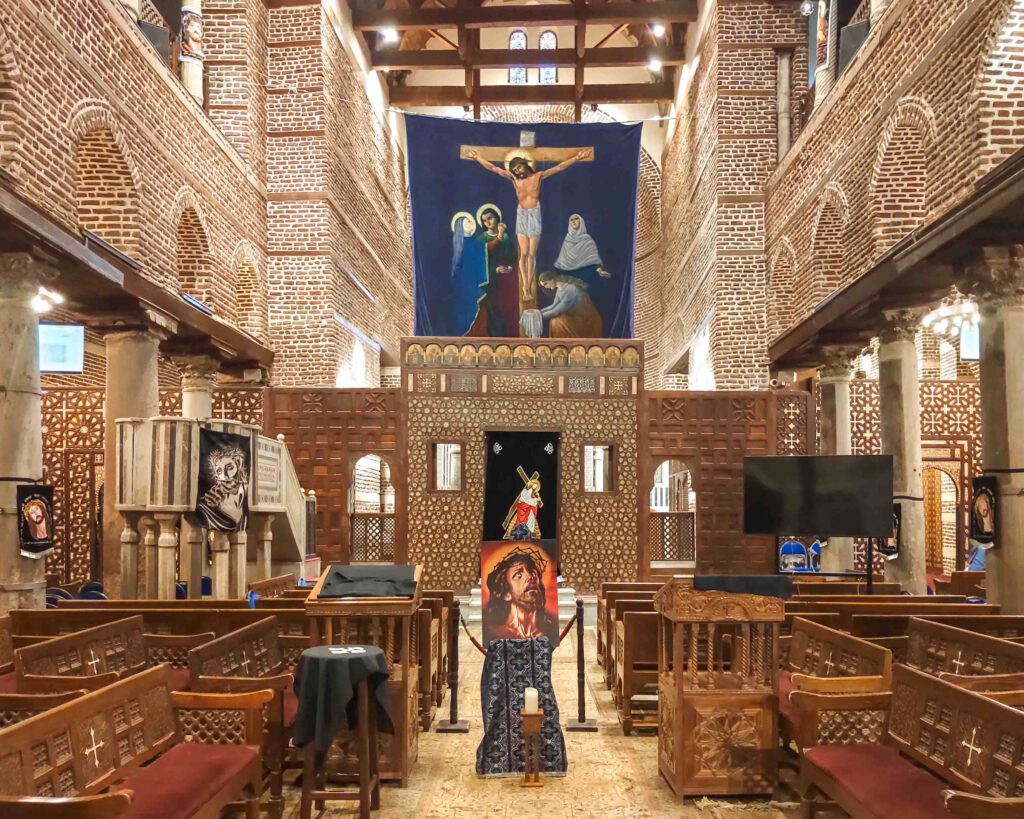
ST GEORGE CONVENT
Dating from the 8thC AD, this nunnery is home to around 40 nuns. It is dedicated to St George, he of the dragon slaying, with some beautiful mosaics depicting his battles with the dragon in the main courtyard. Part of the Chapel is thought to have originally been a Mamluk palace, with inaccurately carved wooden doors nearly 8m tall. At the entrance to the Chapel, there is an iron collar and chain attached to the wall. The nuns of the convent believe this holy relic offers miracles, having been used to torture St George after the Persian King Dadianos ordered the saint’s faith be tested.
ST GEORGE GREEK ORTHODOX CHURCH
Built in the 10thC AD, the original Church was almost completely replaced in 1904 after a major fire destroyed the original Church.
GIZA
THE GIZA NECROPOLIS
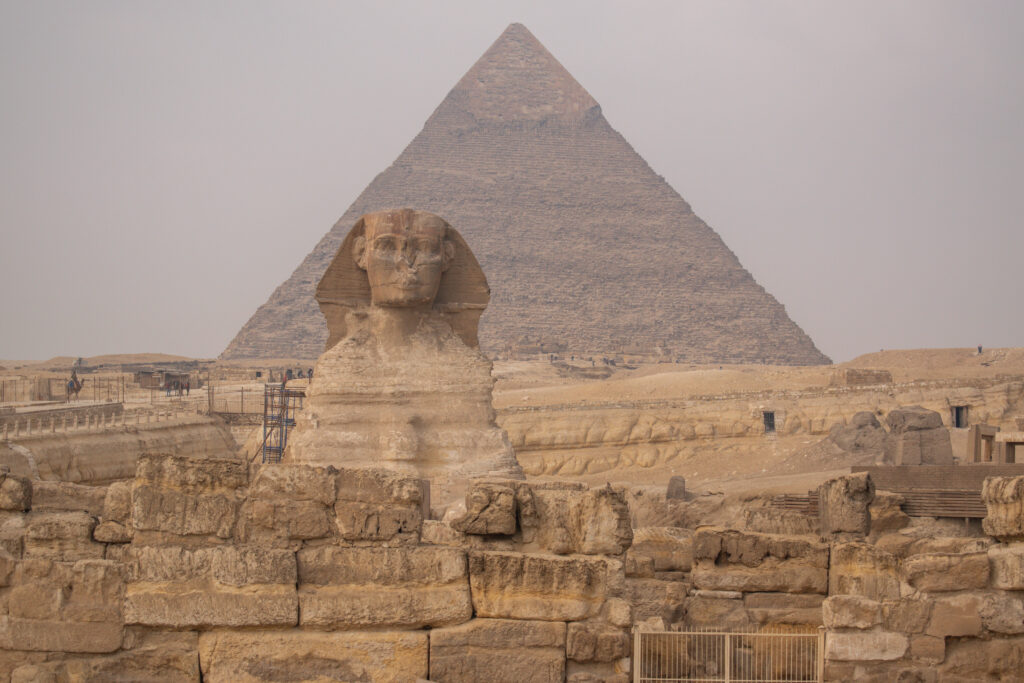
The Giza Necropolis, on the outskirts of Cairo, encompasses the three large pyramids of the pharaohs Khufu, Khafre and Menkaure, as well as a whole host of smaller pyramids, temples, a worker’s village, cemeteries and the Great Sphinx of Giza.
The Pyramids at Giza were constructed over a 20-year period during the reign of King Khufu (2589 – 2566 BCE). The afterlife was essential for culture and belief in ancient Egypt. They believed that after a Pharaoh died, his spirit – his ka – would remain with his body. Both therefore needed to be protected, to ensure they could move together to the afterlife, with all the possessions the Pharaoh would need. The pyramids were therefore intended to be a magnificent burial site to protect the Pharaoh into the afterlife. You can read more about death in ancient Egypt in my reference guide to the Valleys of the Kings and Queens.
The site at Giza is undoubtedly the most overly touristy experience we had in Egypt. And it was a very grey, freezing cold and drizzly day when we visited for the first time. But the excitement of seeing something as truly iconic as the pyramids was impossible to diminish!
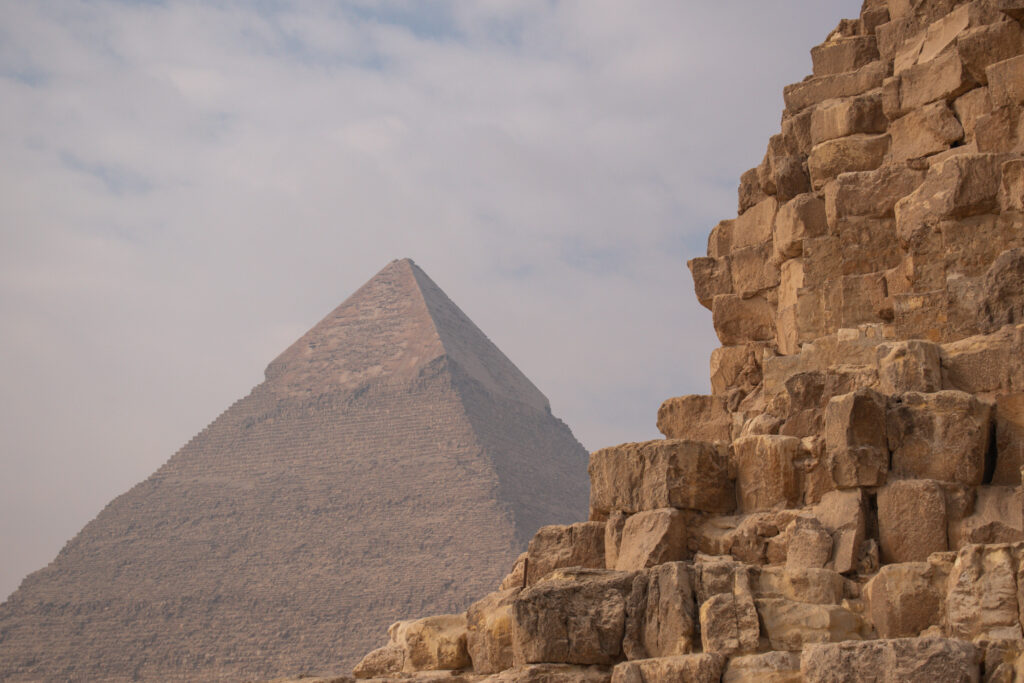
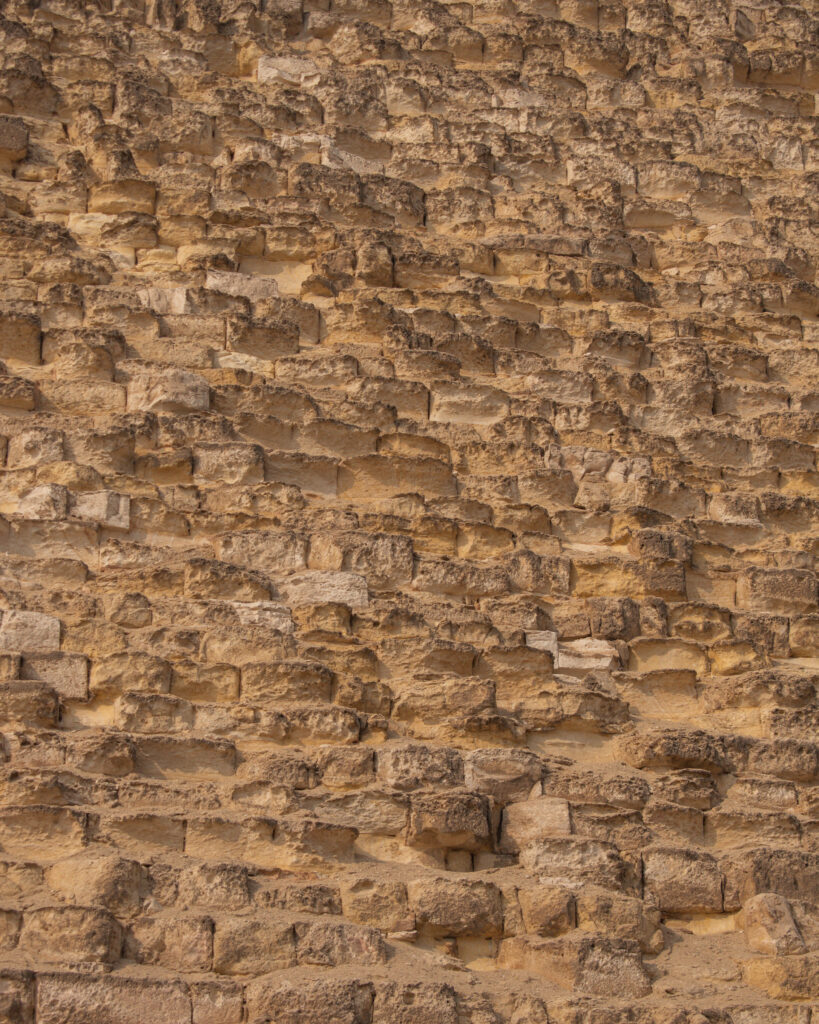
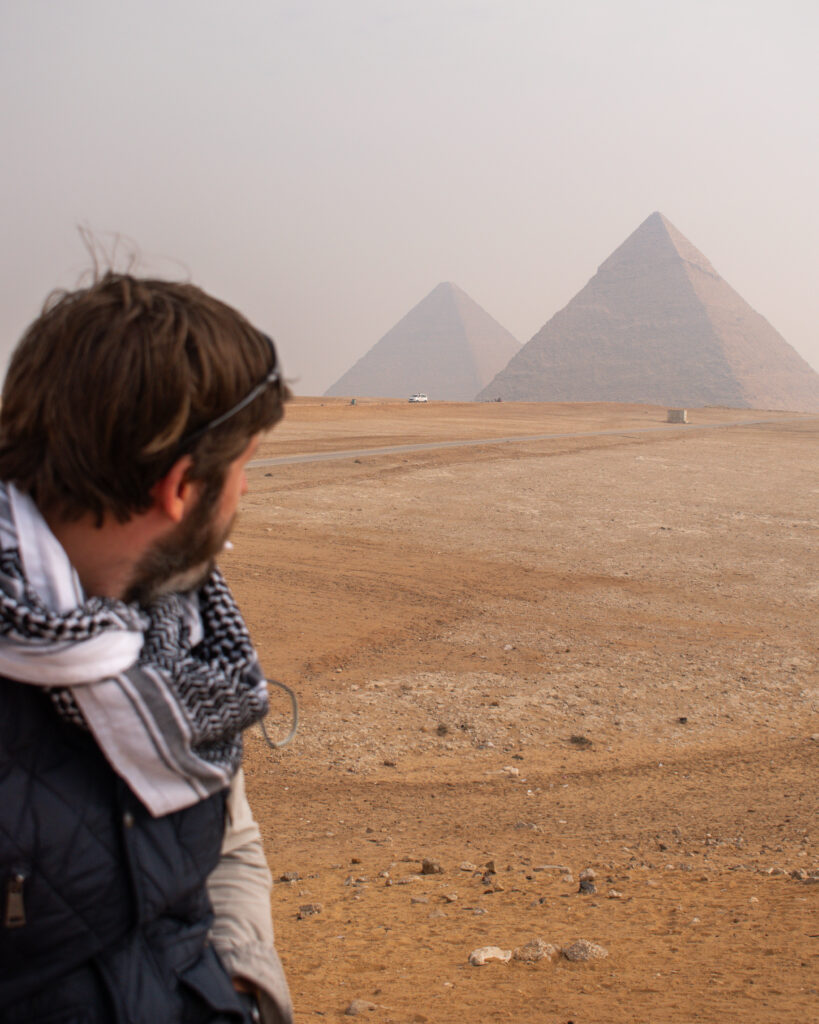
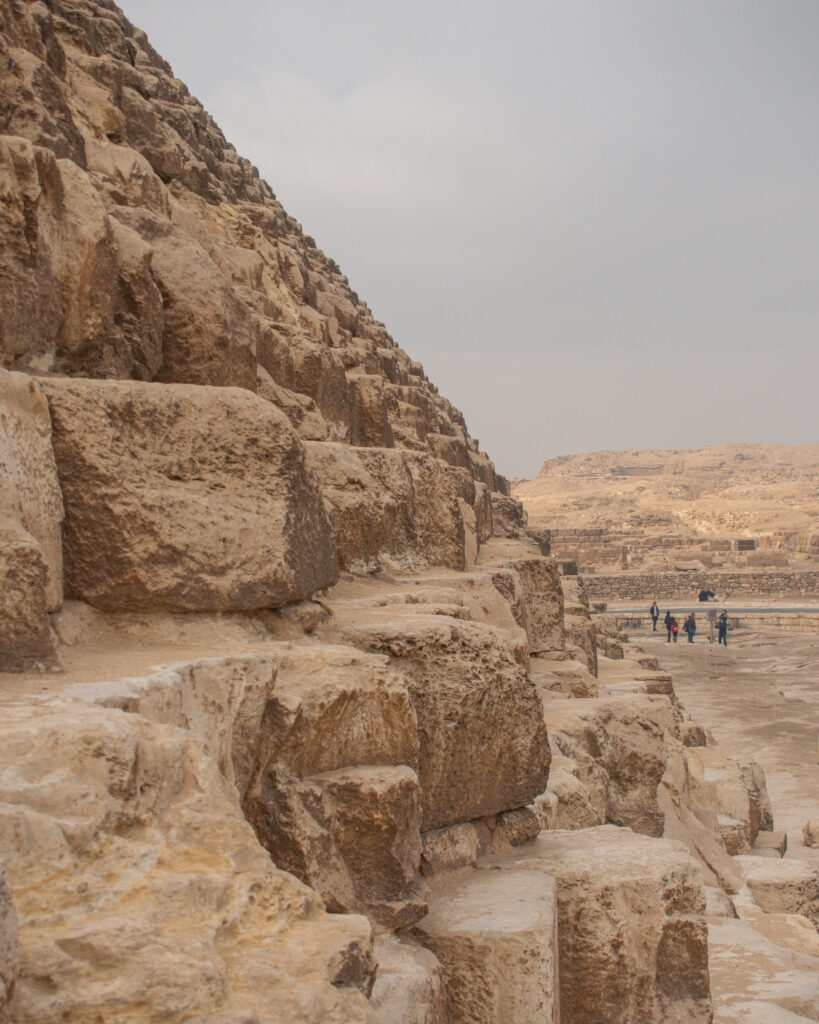

The Great Pyramid of Giza is the largest and the oldest of the Giza pyramids. It is the only remaining of the Seven Wonders of the Ancient World. It is thought to be the tomb of the 4th Dynasty Pharaoh, Khufu. At 481 feet (146.7 meters) in height, it was the tallest man-made building in the world for over three thousand years.
The second largest of the Giza pyramids, is the tomb of the 4th Dynasty Pharaoh Khafre, also known as Chephren, the son of Khufu. It is the only pyramid of the three to retain some of its original casing, a polished white limestone that would originally have covered all of the pyramids and made them gleam in the sun.
The smallest of the three pyramids was built for the Pharaoh Menkaure around the 26thC BCE. Menkaure died before its construction was completed.
THE GREAT SPHINX
The Great Sphinx of Giza is a giant limestone statue (240 feet (73 m) from paw to tail) with the body of a lion and the head of a human, believed to be the head of Khafre, the builder of the second of Giza’s pyramids. Despite its name in Arabic, which translates as “The Father of Dread”, the sphinx of Egyptian mythology is a symbol of strength, intelligence and benevolence. Most historians and archaeologists agree that the Sphinx was probably built around 2500 BCE as part of Khafre’s funerary complex – probably as a guardian of his tomb – and that the sphinx’s face is therefore most likely a likeness of the 4th Dynasty Pharaoh.
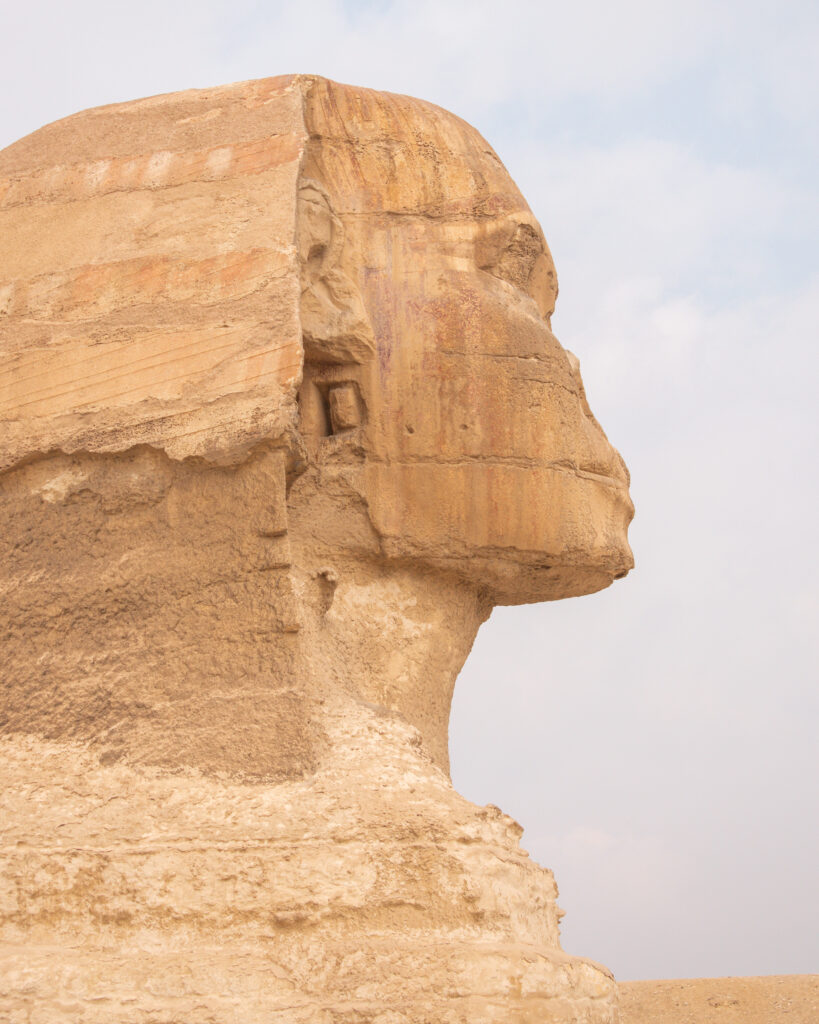
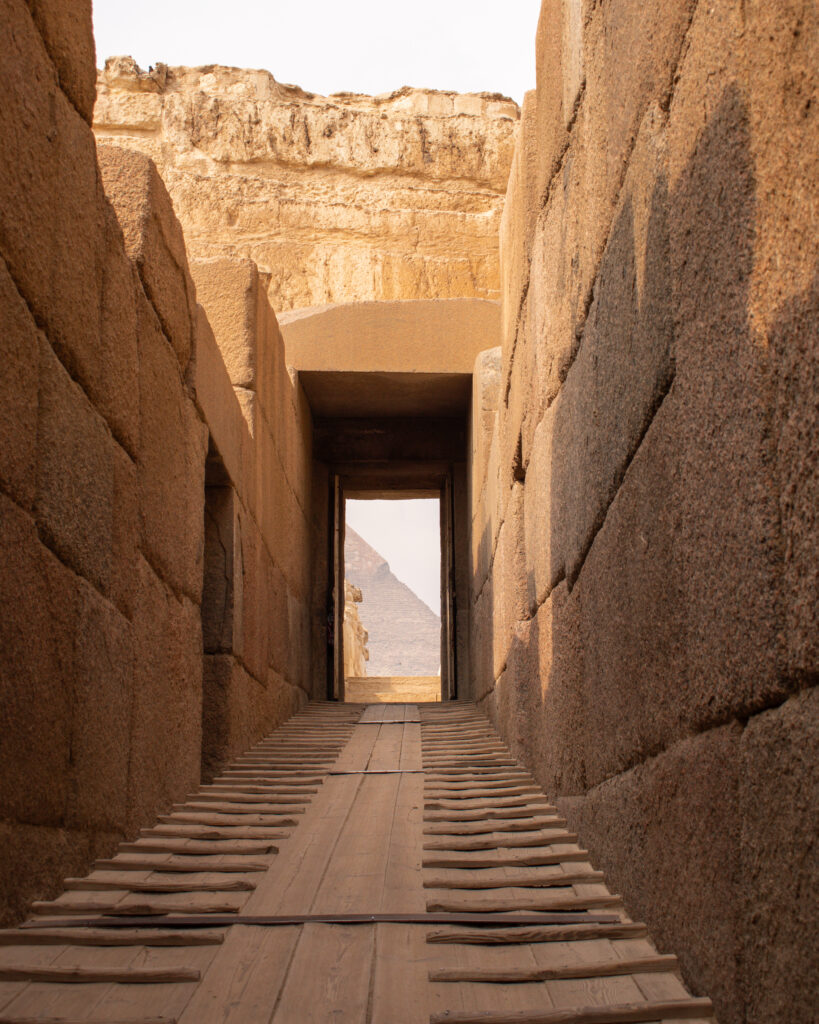
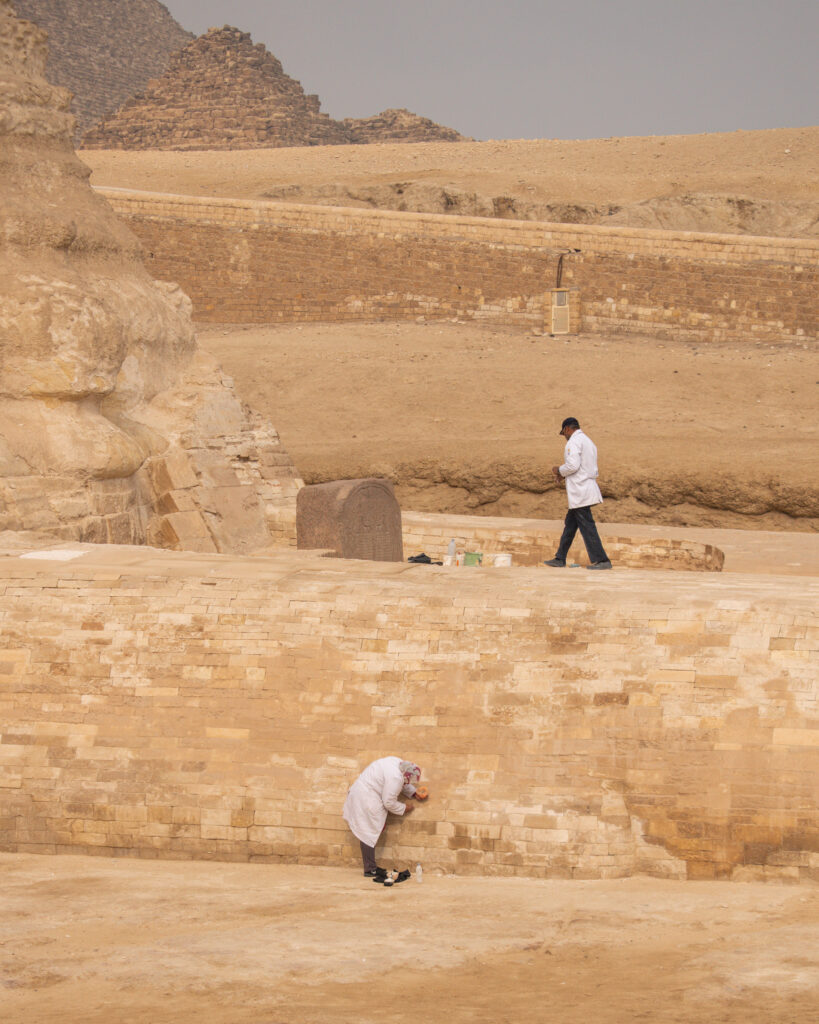
The destruction of the Sphinx’s nose is another mystery. As a Brit, I was very disappointed to discover that the story about those dastardly French breaking the Sphinx’s nose with a cannonball is entirely made up! Apparently, it is thought it was actually most likely damaged sometime in the 14thC.
Entrance to the Giza complex is 240 LE (£6). Open daily 8am to 4pm. It is also possible to enter the Great Pyramid (additional ticket required: 440 LE/£11.25). However, unless this is something you really want to do, I wouldn’t recommended it. It is very crowded, very claustrophobic and very hot! For much of the route, you will need to bend double to fit through the narrow tunnels.
As ever there are plenty of options for private guides and small group tours available, including trips for solo female travellers.
SAQQARA
Lying 12.5 miles/20km south of Giza, is the site of the earliest known Egyptian pyramids, at Saqqara. Saqqara was the ancient royal capital, Memphis. This is Egypt’s largest archaeological site and I wholeheartedly recommended visiting. If you want to see more about one of the most amazing discoveries in recent years, check out the Secrets of the Saqqara Tomb on Netflix. It was this series that finally prompted us to realise our long held dream of visiting Egypt.
The Saqqara necropolis is home to eleven pyramids in total. Nobles were laid to rest here over a period of around 3500 years, particularly when nearby Memphis was the capital city, and the enormous ancient burial ground is littered with other smaller pyramids, tombs, and funerary complexes.
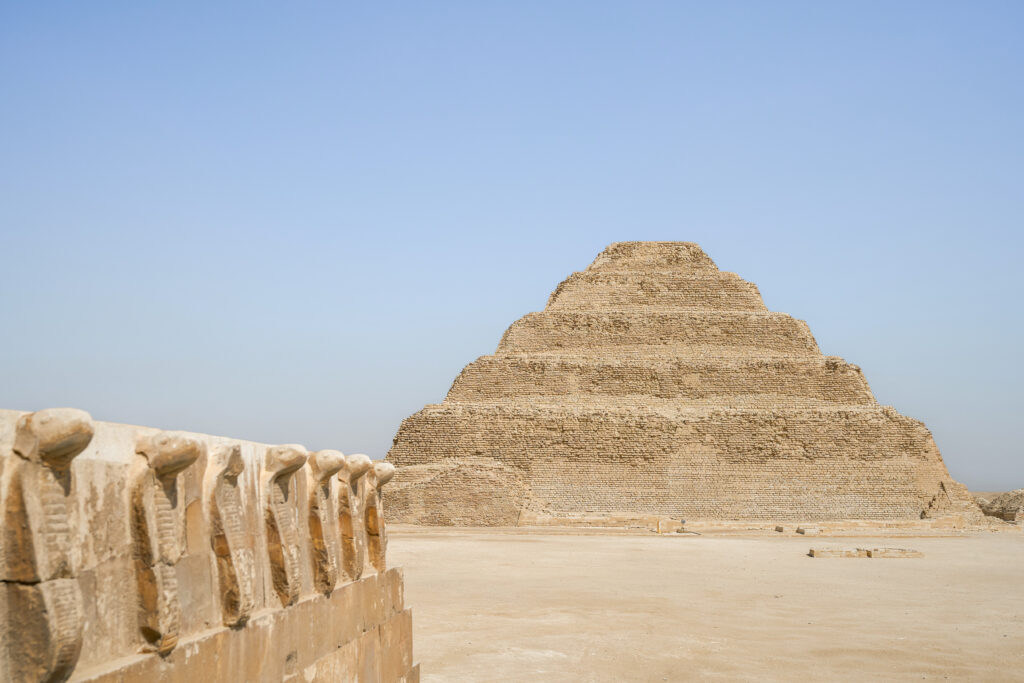
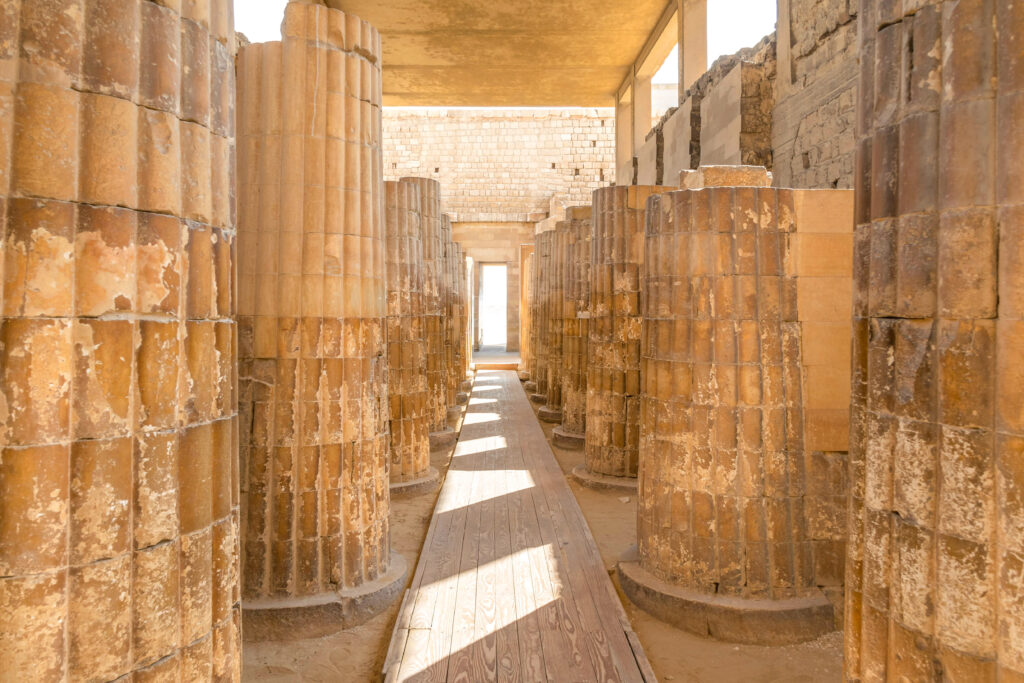
The Pyramid of Djoser – also known as the Step Pyramid– is the oldest intact pyramid in the world. Built by Imhotep – one of the first known architects in history – during the reign of Pharaoh Djoser around 2630 BCE, the Step Pyramid was the central feature of the Third Dynasty ruler’s funerary complex. The step pyramid was the Egyptian’s first successful attempt to build a pyramid and is one of the world’s oldest cut stone structures. Djoser’s Pyramid is historically significant both as a feat of engineering in itself, but also for having paved the way for the construction of the Pyramids of Giza.
Saqqara is considerably less crowded than the Giza Necropolis, as it is still somewhat “off the beaten path” as most tours don’t stop here. This is definitely a site I recommend a guide for, as there is simply so much to see and it is such an important moment for the development of Egyptian antiquity. I would also recommend a private guide at Saqqara, as you will be able to tailor what you want to see more effectively.
The Saqqara Necropolis is open daily, 8am-4pm (except during Ramadan, when the site closes at 3pm). Adult admission to Saqqara and the small Imotep Museum is £150 LE.
WHERE TO EAT
Check out my foodie guide to Cairo for many more recommendations on where to eat in Cairo, and a guide to Egyptian cuisine. If food is your thing, I’d really recommend staying in Zamalek – there were so many fantastic options for food and drink to explore.
Seecoz – really fantastic Greek gyros in Zamalek. The Husband went for a fried chicken souvlaki and I had haloumi. Both were really tasty, fresh and extremely flavourful not least down to the fabulously punchy garlic sauce.
Granita – and authentically bohemian, and somewhat unexpected place in the grounds of the All Saints Cathedral in Zamalek. Full restaurant. It served the best toffee date cake I’ve ever had, and there is also a full menu for more substantial eats. There is inside and outside seating. Service was a bit haphazard (ours was great, but everyone around us had a nightmare trying to order or get their food!), but very friendly!
Abou Tarek – *the* place for koshari in Cairo, it has gained almost mythical status. And it also got the seal of approval from the wonderful Anthony Bourdain – no more needs to be said!
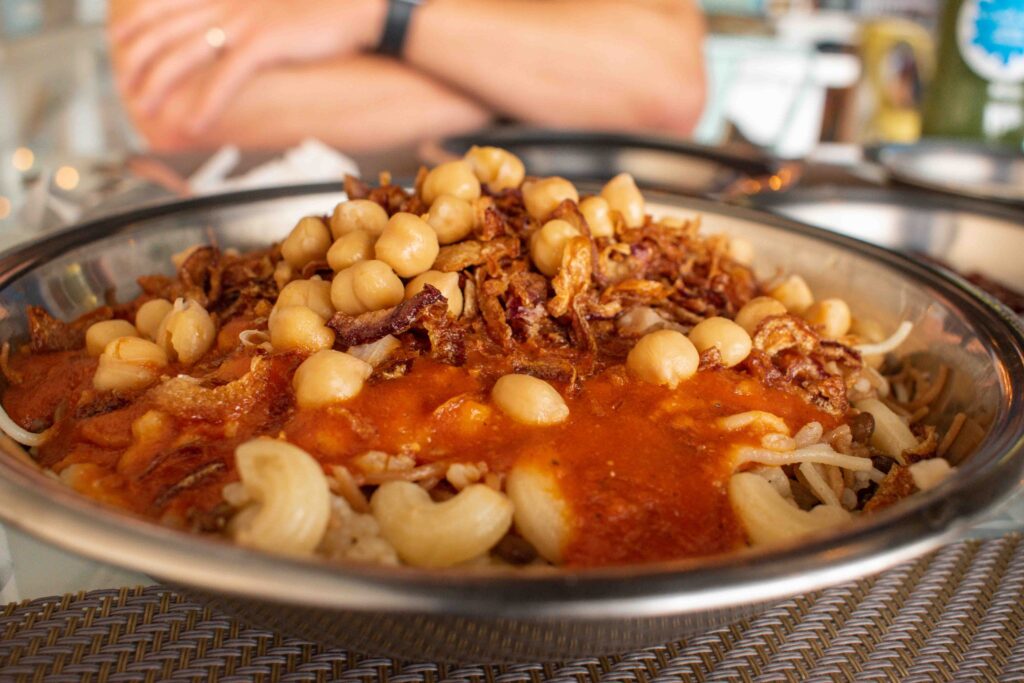
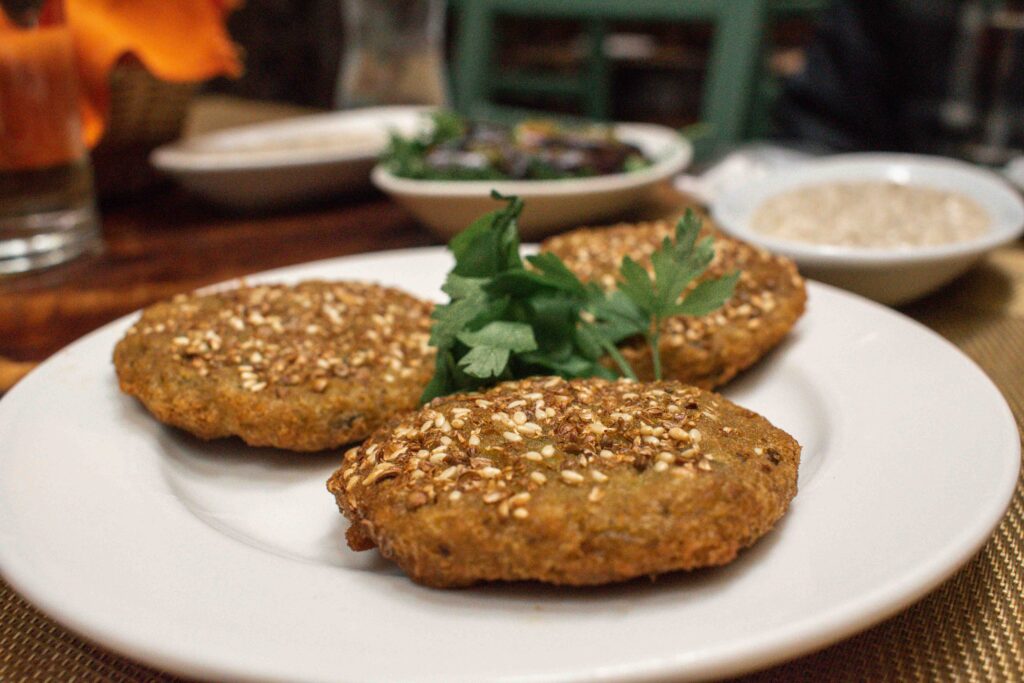
Felfela – within easy walking distance of the Egyptian Museum, this eclectically decorated restaurant in a covered alleyway first opened in 1959. The falafel and baba ghanouj were both addictive, but the completely unexpected standout was the rice pudding – something I usually detest, but I could have devoured multiple sittings here! For a cheaper sampling of their wonderful menu, head to Felfela Takeaway around the corner on Talaat Harb Street.
Simond’s Bakery – French boulangerie come New York deli vibe, which has been serving Cairo residents since 1898.
Visit a traditional Egyptian ahwa – coffeehouse – founded in 1773 Fishawi’s in Khan Al Khalili is thought to be the oldest in Cairo. It has immense charm, despite being endlessly busy.
WHERE TO SLEEP
Sofitel Cairo Nile El Gezirah – elegant communal areas, with fabulous Nile views being almost in the river! Rooms are large, comfortable and most with views out across Cairo. There is a fantastic infinity pool with views onto the Nile, and the indoor jacuzzi pool was pretty fab after a full day sightseeing in the cold winter temperatures. A little tired around the edges – including an alarming line green colour scheme in the bedrooms that Sofitel seem to have decided is needed in all their hotels in Egypt!
Cairo Marriott Hotel and Omar Khayyam Casino – super location within easy walking distance of the great eateries and sweet cafes of Zamalek. Whilst it is missing the dramatic views of the Sofitel, I think the location is better for getting out and about in Zamelek.
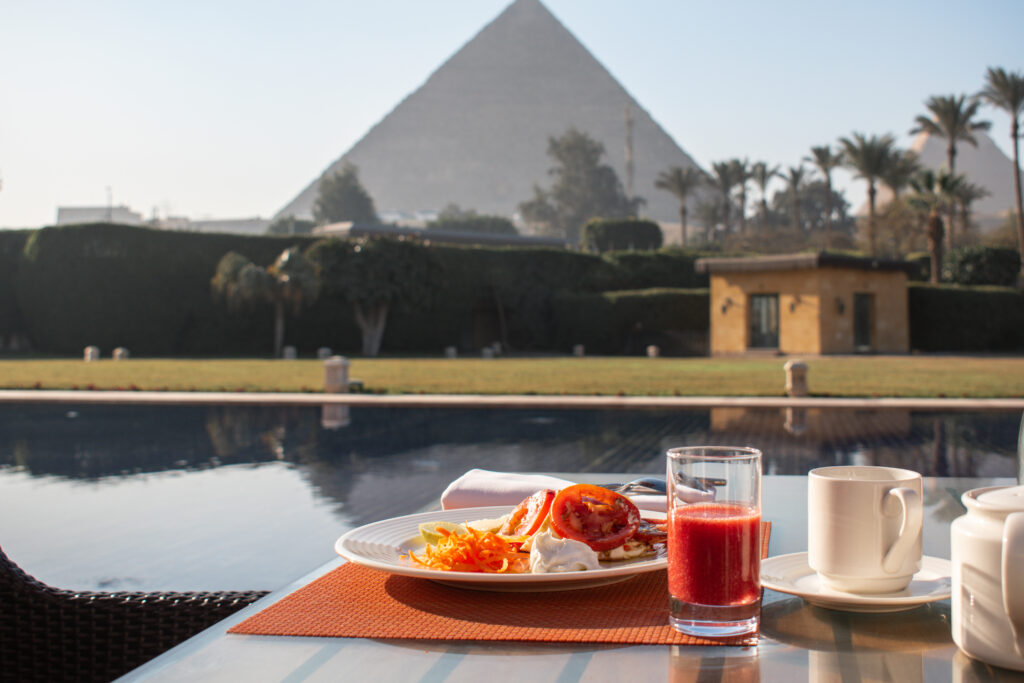
Mena House – one of Egypt’s famous “historic” hotels. Clean, comfortable rooms, but sadly having been entirely renovated by Marriot, rather missing any historic character. Views are hard to beat – directly out onto the Pyramids of Giza from most rooms and the lovely peaceful gardens. Good breakfast spread with mixture of continental and Egyptian options. Check out my fuller review here.
Steigenberger Cairo Pyramids Hotel – whilst not quite as close to the pyramids as Mena House, this large hotel still has great views, but all for much more affordable rates. Excellent breakfast and spacious rooms. Good pool area for the summer months.
There are plenty more Egypt guides on the blog to help you plan your trip. Don’t forget to check out my advice on travelling across the wider Middle East and North Africa for more ideas on where to go next.




Leave a Reply